About the competition
Having now completed its fifth year, Bird Photographer of the Year is an annual international photography competition which celebrates birds.
Heading the judges, naturalist and TV presenter Chris Packham, comments: “These fragile, feathered things not only remind us what a joy life – including our life – is, but also how fleeting it can be if we fail to look after it. And the lives of birds are a reflection of our own. Their predicament is our predicament, and now there’s no hiding from it – we are at the precipice.”
“We have all the wings we need to soar to a successful recovery… the only question is, will we succeed in time? That’s down to you, and me – down to us all. So, please look at and love these photographs, but then get up and do something to make a difference, because there’s a terrifying alternative just around the corner.”
Bird Photographer of the Year is owned by conservation charity Birds on the Brink, and the money generated from the competition will used to award grants to conservation projects that benefit birds.
To view the images as a slideshow, click on the arrows in the top right-hand corner of the photos below.
Category: Overall winner (also Best Portrait, Gold award winner)
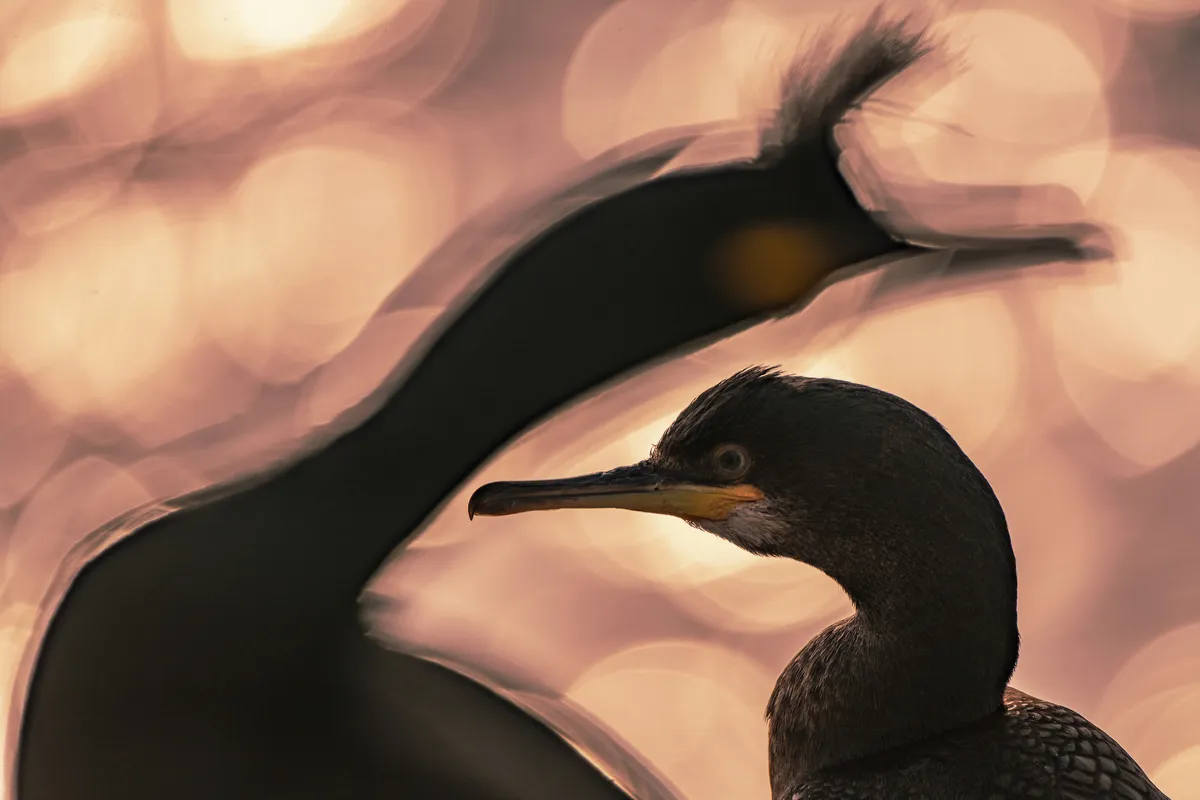
END OF THE DAY. European shag (Gulosus aristotelis). Vardø, Norway. Majed AlZa’abi, Kuwait.
I took this shot in April 2019 while on a visit to the famous Norwegian seabird island of Vardø, a location packed full of birds that provide endless opportunities for photography. It was my first visit to the island, one that was prompted by hearing about its birdlife. Despite being forewarned, I was really amazed by what I saw: hundreds of birds flying all the time, all day during the five days we visited.
It was my plan to stay with a particular subject over an entire day: one day with Atlantic puffins, another day with European shags and so on. Also, there are a lot of opportunities for creative composition, playing with foreground and background; here I like the out-of-focus shag framing the in-focus individual, plus the bokeh of the sea as sunset approached. By experimenting, I aimed to create artistic and impressionistic shots of shags, and I hope I achieved my goal with this image.
Judges’ comment: “To win this competition it takes a very special photograph. Technical perfection is simply not enough; it is the imaginative eye and a mind that seeks out the unusual and the artistic in the everyday that will do well. The vast majority of the 15,000 images entered annually are of an amazing standard, sufficient eye candy to feed even the most visually gluttonous.
But create a photograph that makes us sick with envy or cry out with uncontained excitement, then you are in with a chance. When that collective shout from the judges is ‘I wish I had taken that myself’, then you are onto a winner. Well done Majed for sharing this stunning image with us – it is a well-deserved winner.”
Category: Best Portrait, Silver award winner
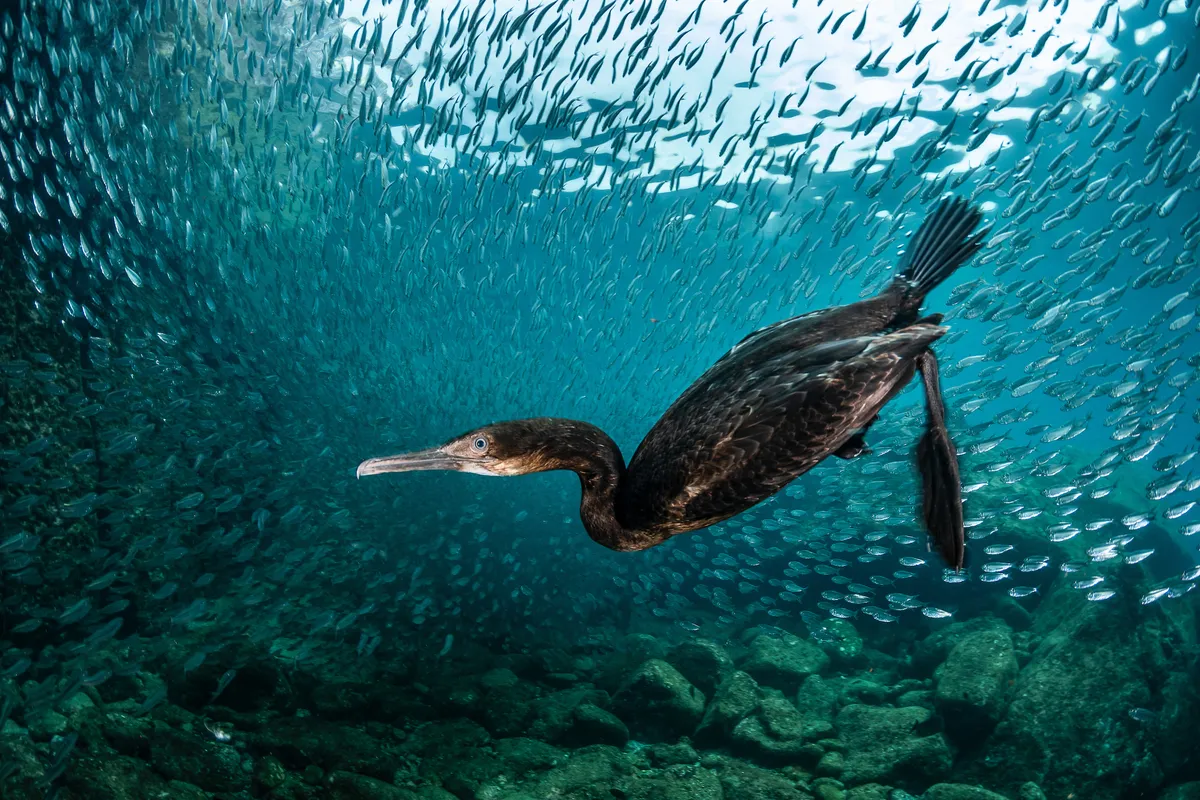
CORMORANT UNDERWATER VIEW. Brandt’s cormorant (Urile penicillatus). La Paz, Baja California, Mexico. Greg Lecoeur, France.
Like others of its kind, Brandt’s cormorant is an adept swimmer whose diving skills come into their own when the bird is pursuing prey (mainly fish) underwater. This particular individual was swimming underwater in the hope of catching sardines. To achieve this portrait, rather than chase the bird I tried to blend into the scenery, as much as a diver ever can, and waited for the cormorant to swim by, framed by the fish it was trying to catch.
Category: Best Portrait, Bronze award winner
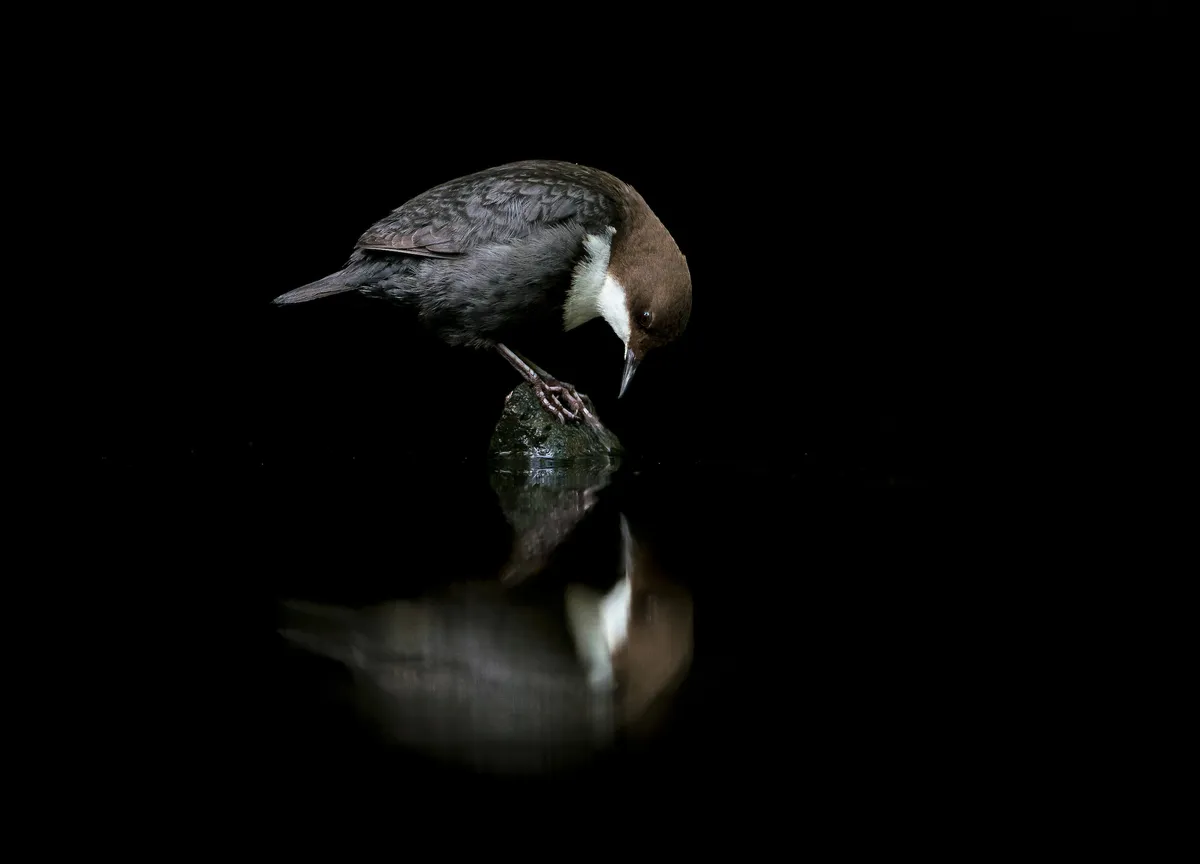
A DIPPER IN THE MIRROR. White-throated dipper (Cinclus cinclus). Levanger, Trøndelag, Norway. Terje Kolaas, Norway.
As a general rule, white-throated dippers tend to prefer the fast-flowing parts of the river they live in. However, this unusual and atypical individual had its favoured fishing spot in a calm pond close by. The tranquil surface of the water was a perfect mirror and created an almost flawless reflection, the effect enhanced by the dark backdrop of the surroundings.
Category: Bird Behaviour, Gold award winner
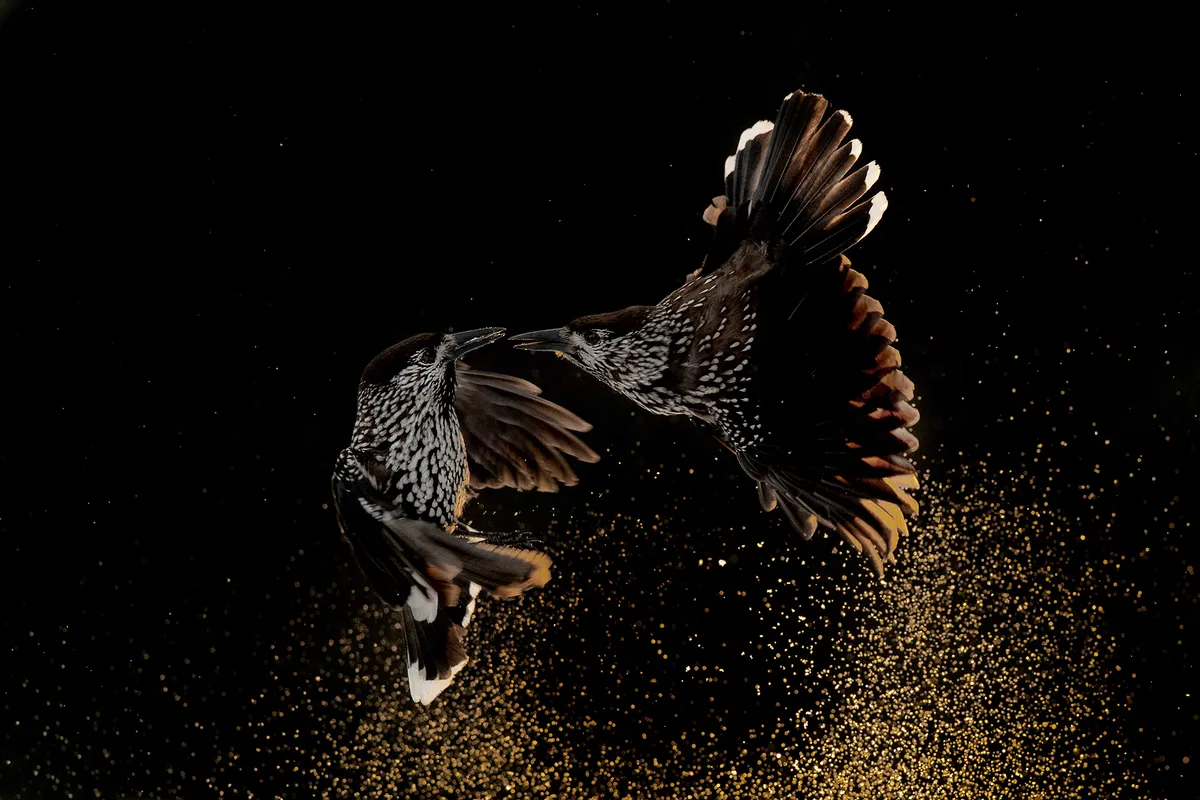
NUTCRACKERS FIGHTING IN THE SNOW. Northern nutcracker (Nucifraga caryocatactes). Sofia, Bulgaria. Roelof Molenaar, the Netherlands.
Northern nutcrackers are intelligent and rather sociable birds, and I took this photograph on a ski piste in Sofia, Bulgaria. Due to the large number of birds in the area, fights broke out on a regular basis. In this image I made use of the snow. The dark background emphasises the snow and the backlit wings of the birds.
Category: Bird Behaviour, Silver award winner
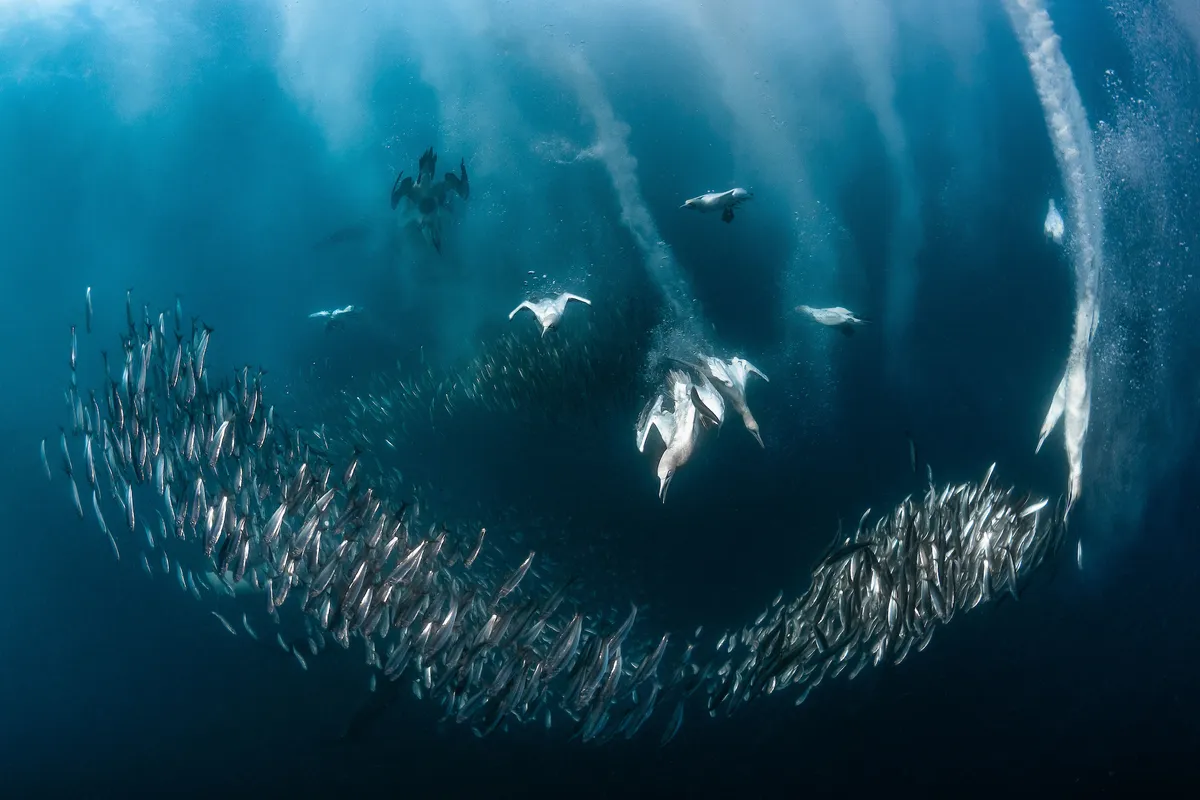
FEEDING FRENZY. Cape gannet (Morus capensis). Port St Johns, South Africa. Greg Lecoeur, France.
Every year, vast shoals of sardines migrate along the South African coast and predictably attract all manner of predators – everything from dolphins and other large fish beneath the water, to seabirds diving from above. Among the latter, Cape Gannets are most in evidence and plunge-dive for their prey.
Obtaining as photograph like this one was always going to be a challenge and several things had to fall into place. It took eight visits to South Africa before I was able to take this perfect shot, which shows the concerted manner in which the predators feed.
Category: Bird Behaviour, Bronze award winner
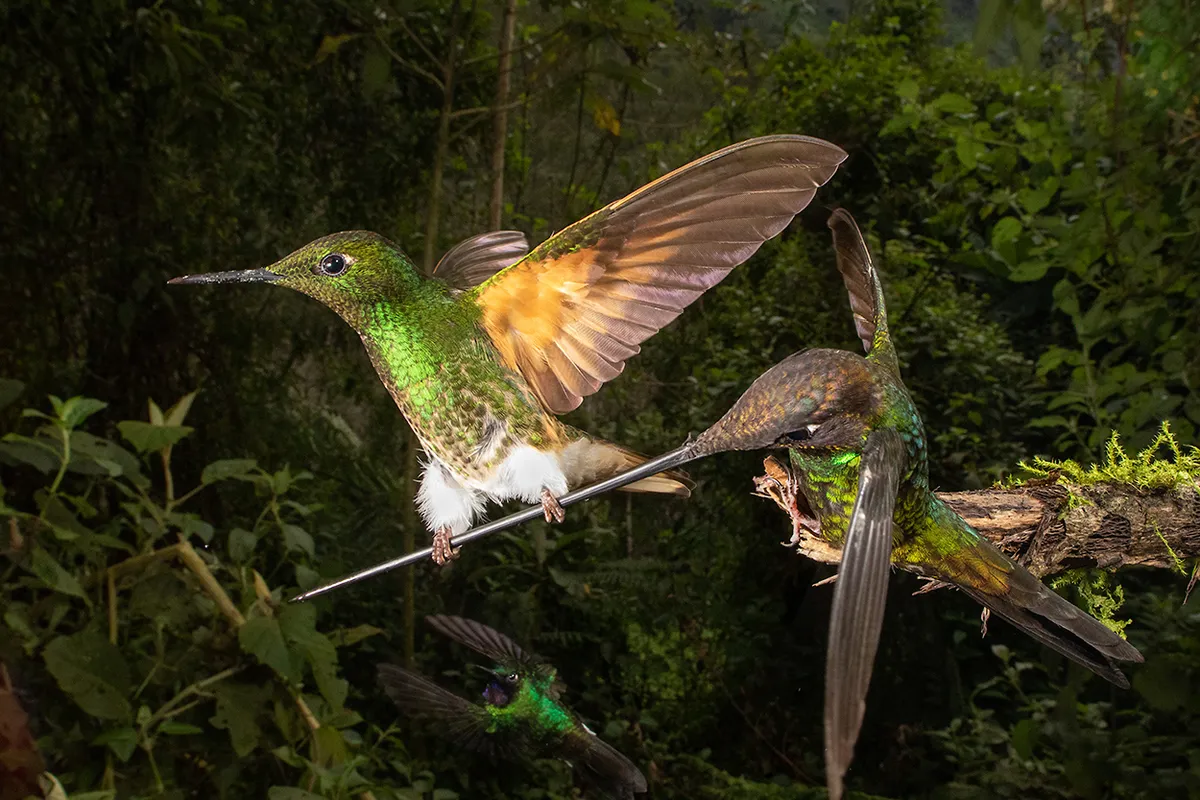
ROPEWALKER. Sword-billed hummingbird (Ensifera ensifera). Papallacta, Ecuador. Nicolas Reusens, Sweden.
On my last trip to Ecuador I had the luck of watching a very unusual bird coming to a feeder - the incredible sword-billed hummingbird! They usually avoid sugar-water feeders, but this specimen seemed to be brave enough to visit from time to time (every 30-60 minutes). I realised this was going to be a very intense week, and instead of travelling the country I decided to get as many sword-bill pictures as I could.
I needed four flash guns, a remote trigger on the camera and tonnes of patience in order to get this capture. I spent six full-on days, busy from 6am to 6pm, on the task, and it wasnt until the very last afternoon that I got one of the most unusual images of my life! It was definitely a once-in-a-lifetime shot, and also of a very shy bird: the amazing sword-billed hummingbird.
Category: Birds in Flight, Gold award winner
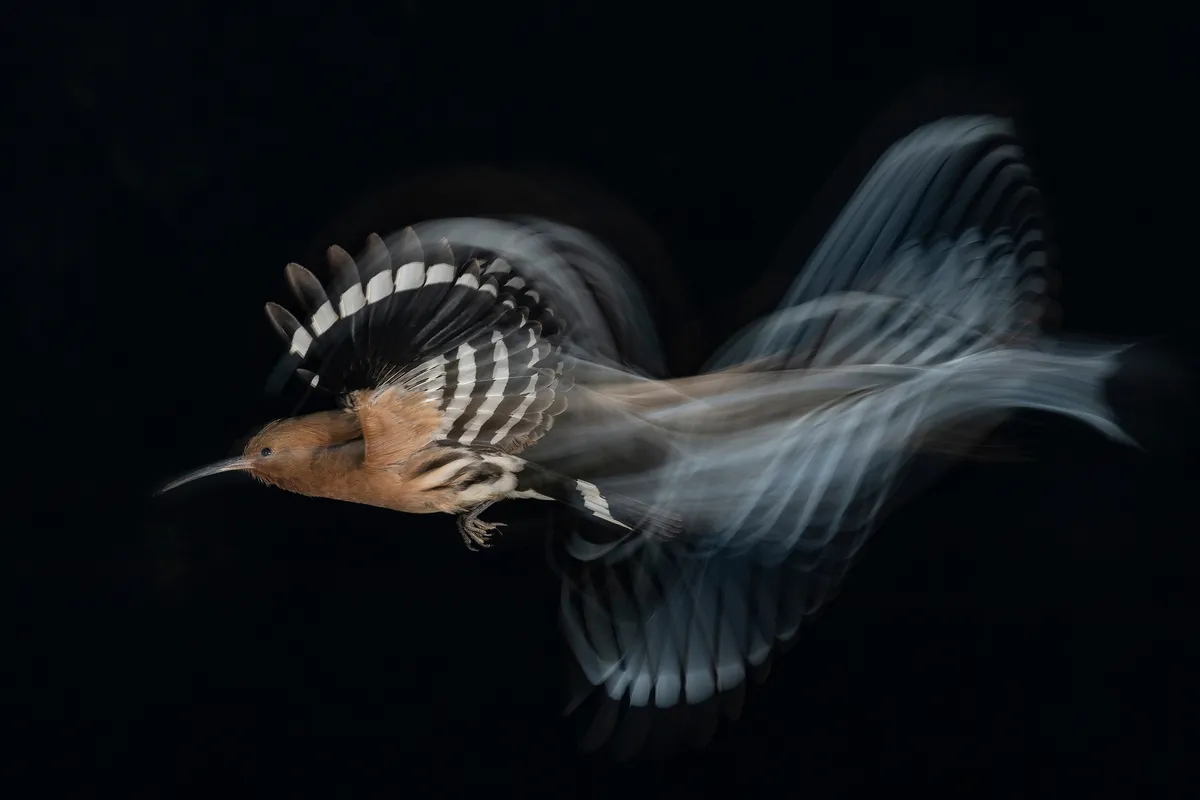
HOOPOE FLIGHT AT LOW SPEED. Common hoopoe (Upupa epops). Israel. Gadi Shmila, Israel.
I had this image in my head long before it was created. Once I found the exact location for the image, I began several attempts until I found the balance between blur and freeze. To get the right ‘smudge’ you need very weak lighting, combined with a low shutter speed (1/8 second). By contrast, ‘freezing’ action requires a very high shutter speed or alternatively the use of flash.
In this photo, I froze the action with the help of four flashes that were triggered at the end of the exposure. In my many different attempts, I felt the blur was not sufficiently bold, so to emphasise it I placed a black background behind the subject.
Category: Birds in Flight, Silver award winner
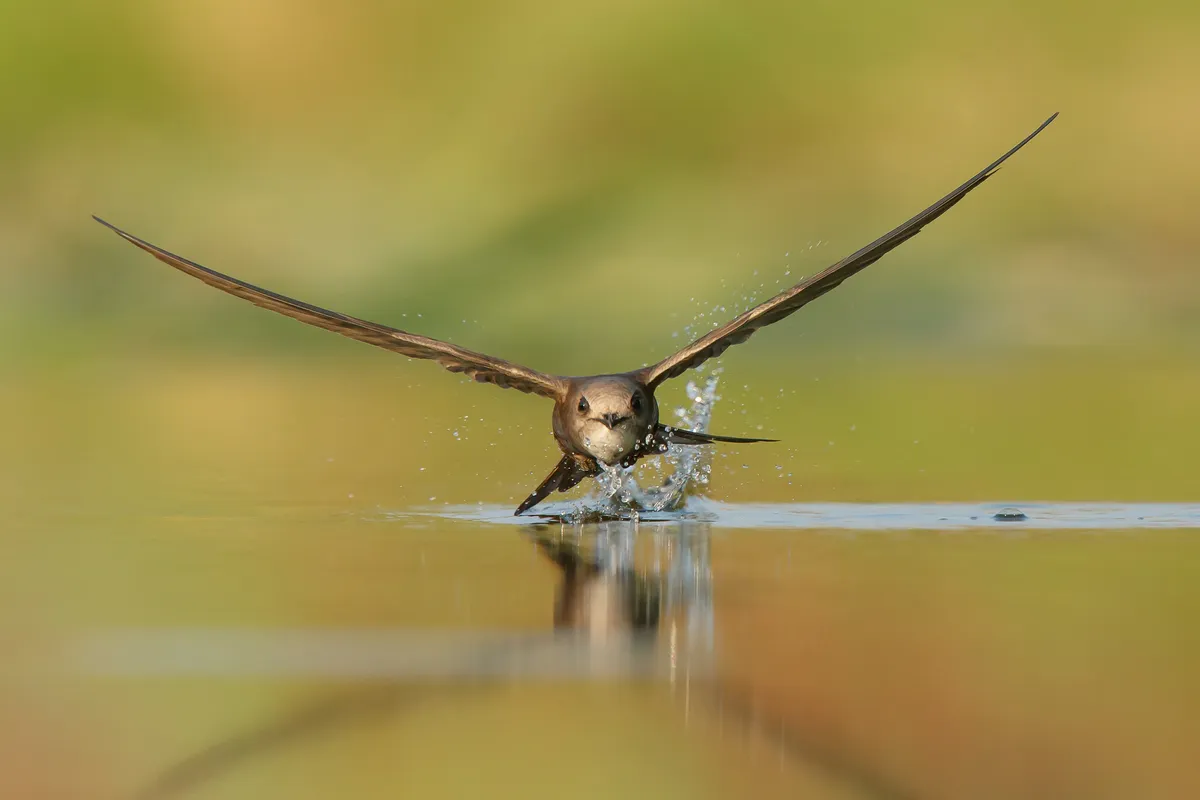
TOUCH AND GO. Pallid swift (Apus pallidus). Athens, Attica, Greece. Nikos Fokas, Greece.
Pallid swifts are breeding visitors to Greece, and during the summer months they perform spectacular dives into this small pool of water. They appear one after the other, as if they are competing to see which one will do the best dive or else the best surface-skim. This particular one won that year’s competition by performing a high-speed open-winged dive with a splash, catching floating insects while keeping eye contact with the camera. I would award it ten out of ten for style and performance.
Category: Birds in Flight, Bronze award winner
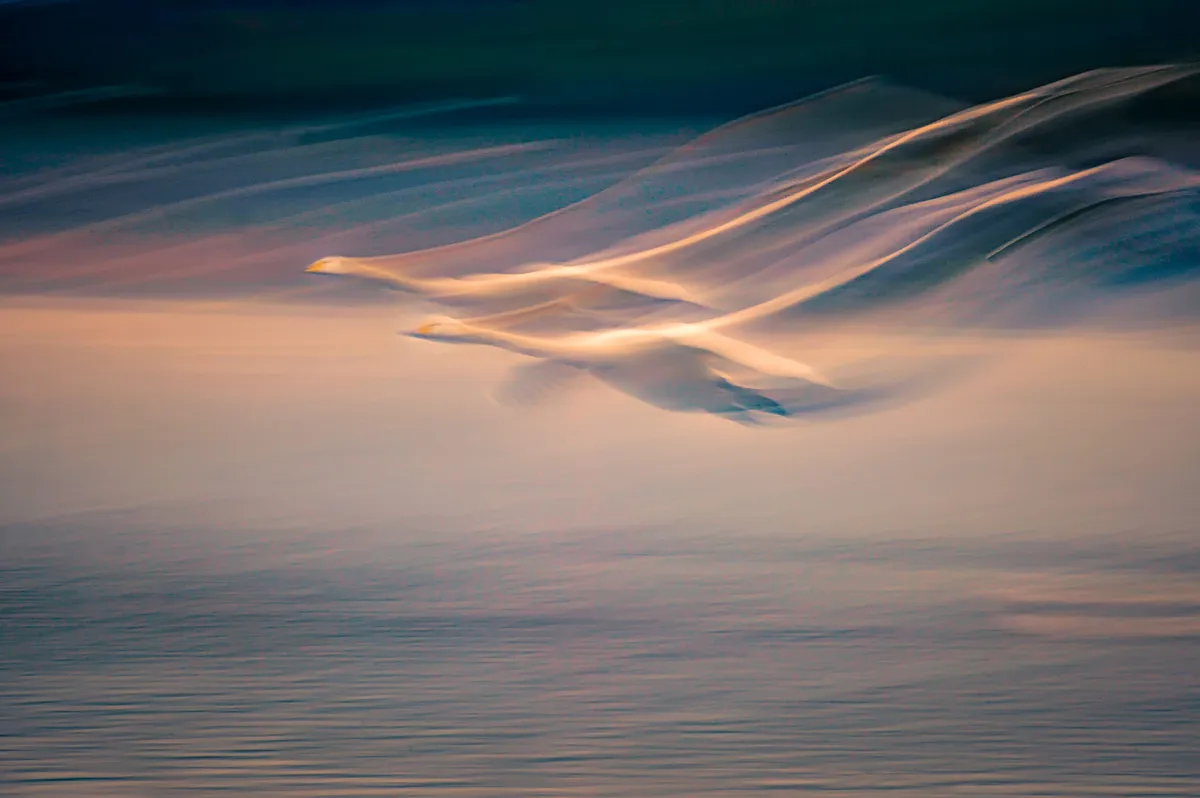
FAIRY LANDING ON EARTH. Whooper swan (Cygnus cygnus). Sanmenxia, Henan, China. Shu Qing, China.
This image was taken in Sanmenxia city, China, on 16 November 2018 using a slow shutter speed, while panning the camera to track the movements of the birds. I think the result is a beautiful and evocative work, and it was shot at a speed of 1/4 second; the ‘shake’ that resulted from hand-holding the camera only served to highlight and enhance the beauty of the flying swans.
Category: Birds in the Environment, Gold award winner
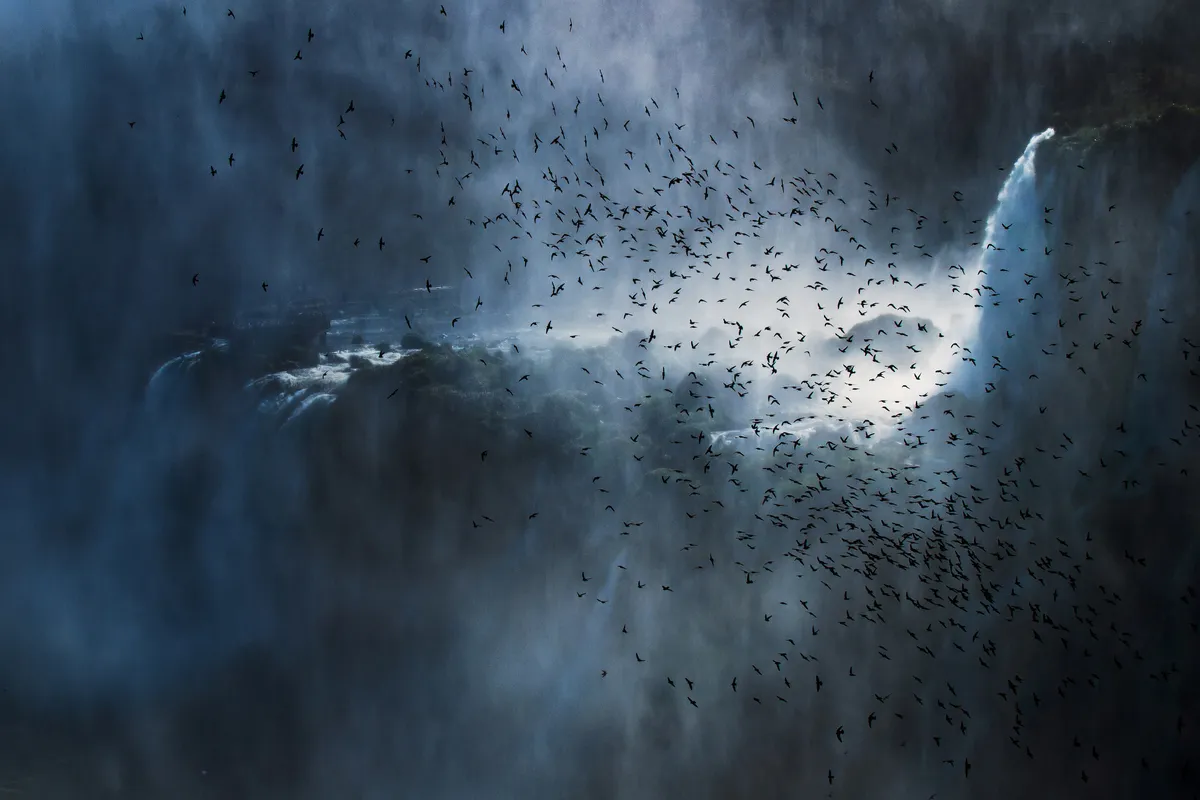
SWIFTS OVER IGUAZÚ FALLS. Great dusky swift (Cypseloides senex). Iguazú Falls, Misiones, Argentina. Francesco Filippo Pellegrini, Italy.
A few years ago I had a chance to visit the world-famous Iguazú Falls with my wife. Even though I had been told it was an amazing place, I nevertheless felt overwhelmed by the beauty of the valley: I was not prepared at all for the spectacle. Waterfalls are amazing places for photography, with a variety of wildlife sometimes framed by rainbows caused by the mist of the cascades.
In Iguazú’s unique environment, the ‘swifts of the falls’ find the perfect shelter for breeding. While I was staring at a feature called the Devil’s Throat, I saw flocks of these birds flying all around. Due to the mist caused by the falls, I struggled taking this shot as I had to keep the front of the lens free of water drops.
Category: Birds in the Environment, Silver award winner
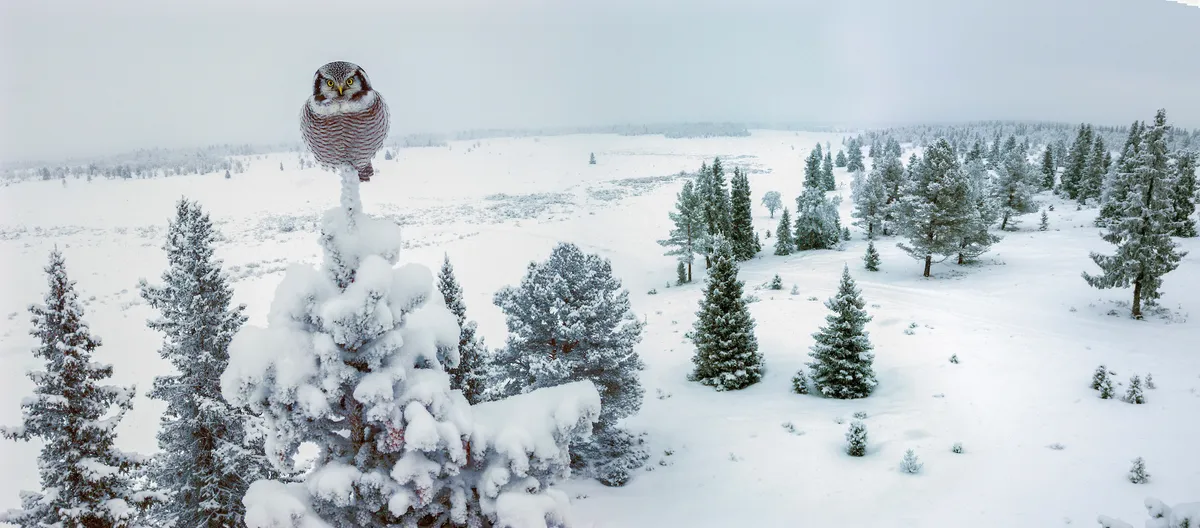
HAWK OWL IN A MOUNTAIN FOREST. Northern hawk-owl (Surnia ulula). Golsfjell mountain region, Norway. Pål Hermansen, Norway.
This northern hawk-owl spent several hours in the top of the tree, looking over the winter landscape for food. As I realised the bird was very bold and fearless, I carefully launched my drone and approached it very slowly. The owl did not react, and allowed the drone to hover reasonably close. After finishing the photography, I backed off with the drone, leaving the bird perched for a further hour before it moved to another tree top.
Category: Birds in the Environment, Bronze award winner
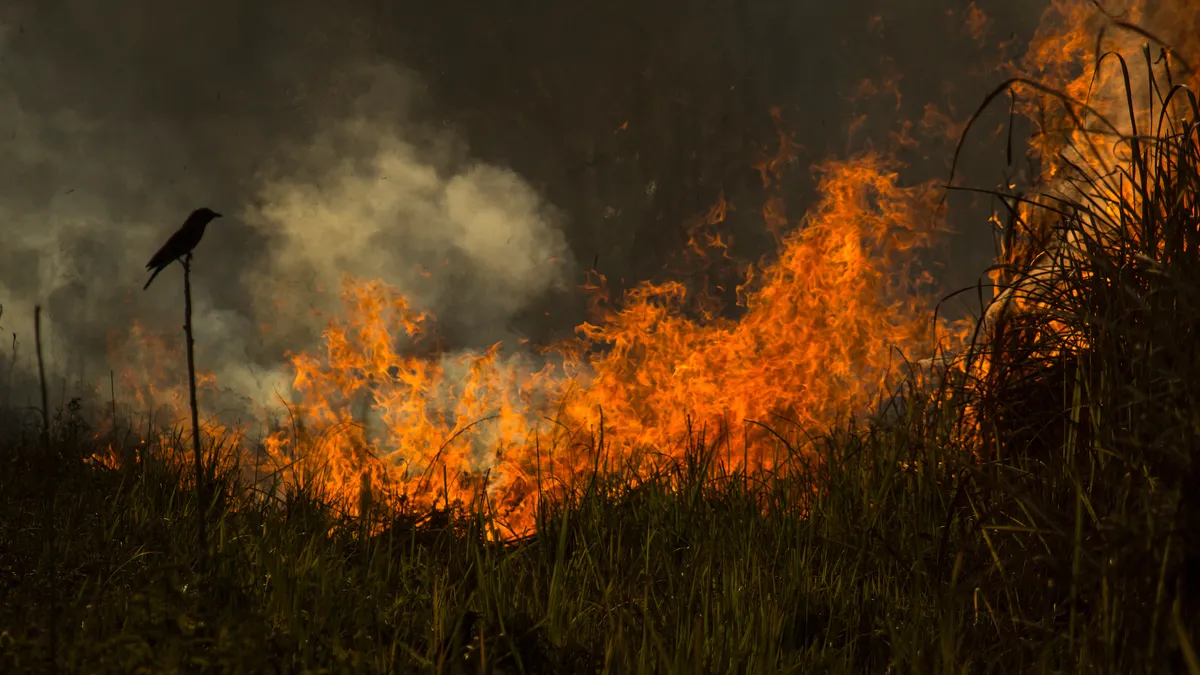
A NEW BEGINNING. Indian roller (Coracias benghalensis). Kaziranga National Park, India. Swayamsiddha Mohapatra, India.
What appears to be destruction is actually regeneration in disguise. This is a frequent sight in Kaziranga National Park during late winter, when every year the forest officials set the grassland alight, patch by patch; the practice is a part of habitat management. The grasslands support a large number of herbivores, ranging from Indian hog deer to the Vulnerable Indian (or greater one-horned) rhinoceros.
Tall grasses start to dry off by January, which reduces their nutritional value. Burning the grasses causes new, nutritious grasses to grow. The practice is also known to arrest the successional process whereby grassland eventually becomes forest, a process that is known to have increased thanks to vegetation mapping surveys of India.
Kaziranga is divided into approximately 30 blocks based on various features, such as vegetation and natural topography. Each block is burned one by one and patch by patch. During the burning, a plethora of birds congregate near the site to eat insects that are driven out by the fire. We had stopped near one such burning site when we spotted a huge congregation of Indian rollers. Here, a roller can be seen sitting on a pole waiting for the right moment to grab a bite. Using spot metering and by purposefully underexposing the image, I was able to get the desired result.
Category: Black and White, Gold award winner
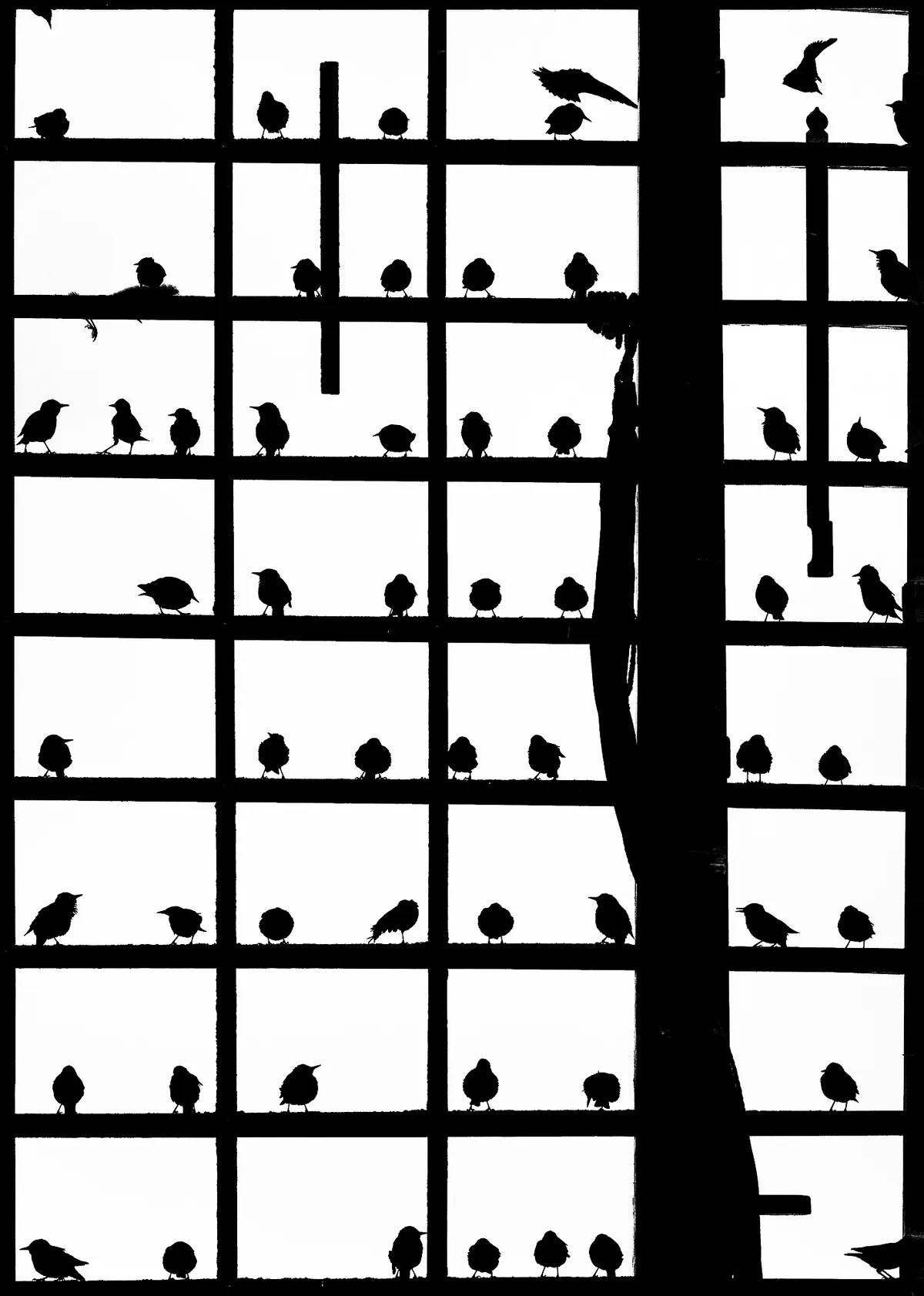
SINGLE ROOM AVAILABLE. Common starling (Sturnus vulgaris). The Netherlands. Robert Sommer, Germany.
One day, I spent the period around sunrise photographing a windmill in the northern Netherlands. From nowhere, I noticed twittering calls, which became louder and louder, and it turned out that common starlings were producing the sound.
By the end of the shoot, the upper part of the windmill was full of starlings, so I went to my car to get a longer lens and tried to capture the abstract scene. Because of the strongly geometric form, I decided that the image worked better in black and white than it did with its original colour.
Category: Black and White, Silver award winner
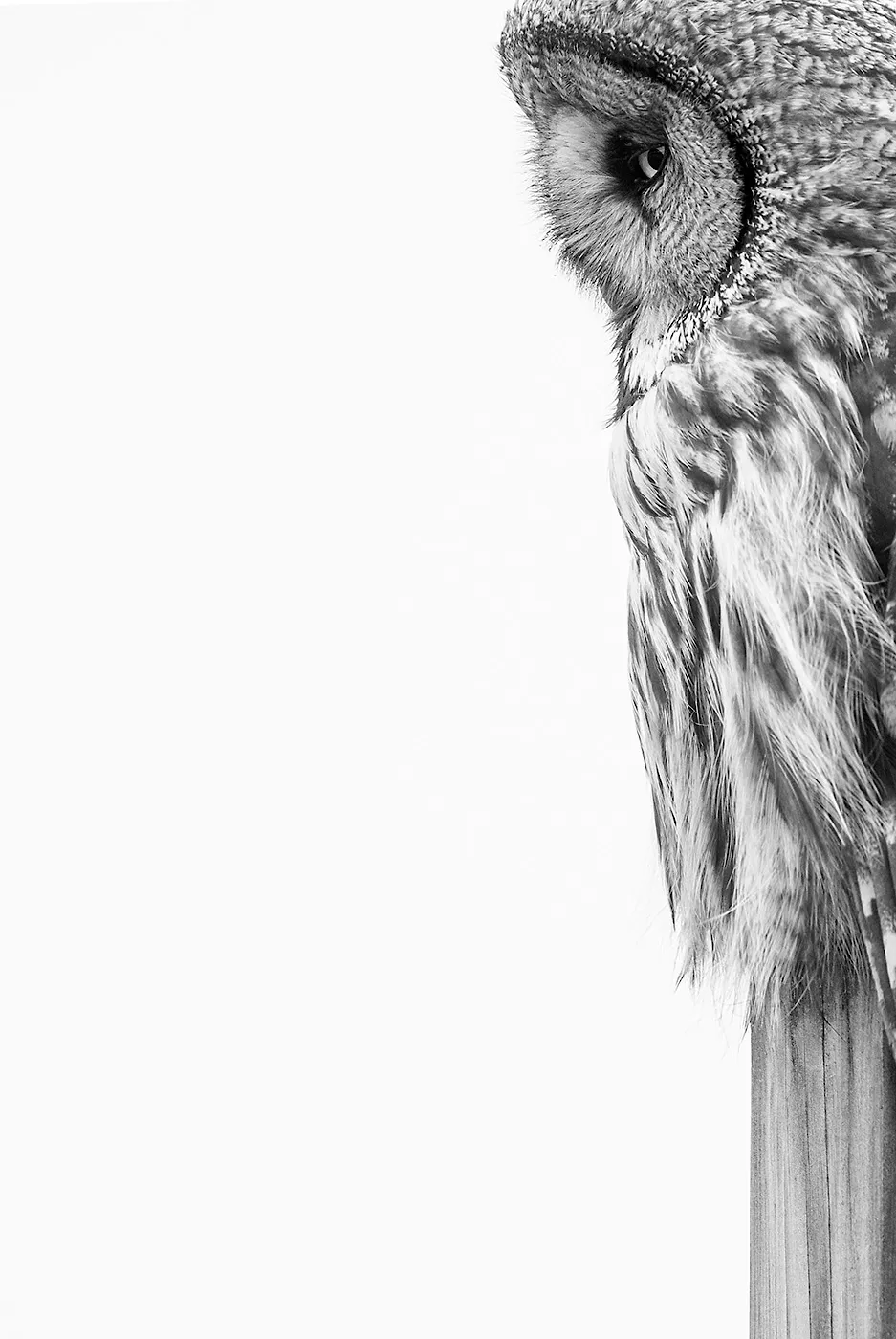
GREAT GREY OWL. Great grey owl (Strix nebulosa). Nynäshamn, Stockholm, Sweden. Daniel Stenberg, Sweden.
As a photographer, sometimes you are just lucky. Most of the time you drive around you find nothing, but on this occasion I came across a great grey owl using a post beside the road as a lookout. After taking the usual portrait shots, here I focused on composition in order to create a more graphic depiction of the bird. I felt the shot worked best in black and white.
Category: Black and White, Bronze award winner
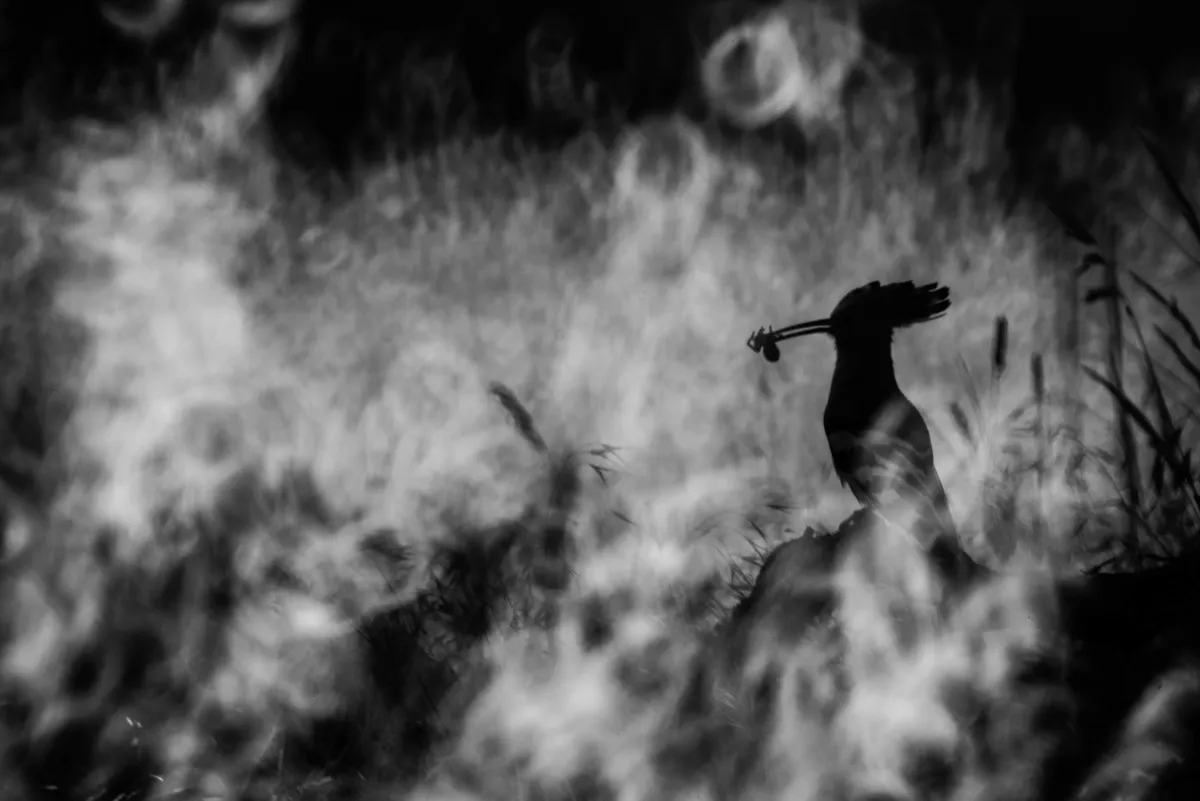
PYROGRAPHY. Common hoopoe (Upupa epops). Gijón, Spain. Juan Pablo Plaza Pozo, Spain.
Intentional use of black and white, a catadioptric (mirror) lens, the sun as a backlight, and a common hoopoe… this is a combination whose results can re-create the appearance of pyrography. During the breeding season, it is usually easy to identify hoopoe patterns of behaviour, and in this case locate where this bird was nesting.
To obtain this image, I made sure I was in position before sunrise. Using a low angle for shooting and an old catadioptric lens (500mm), I hoped there was a good chance I could create a different image of a hoopoe feeding its chicks with a spider.
Category: Attention to Detail, Gold award winner
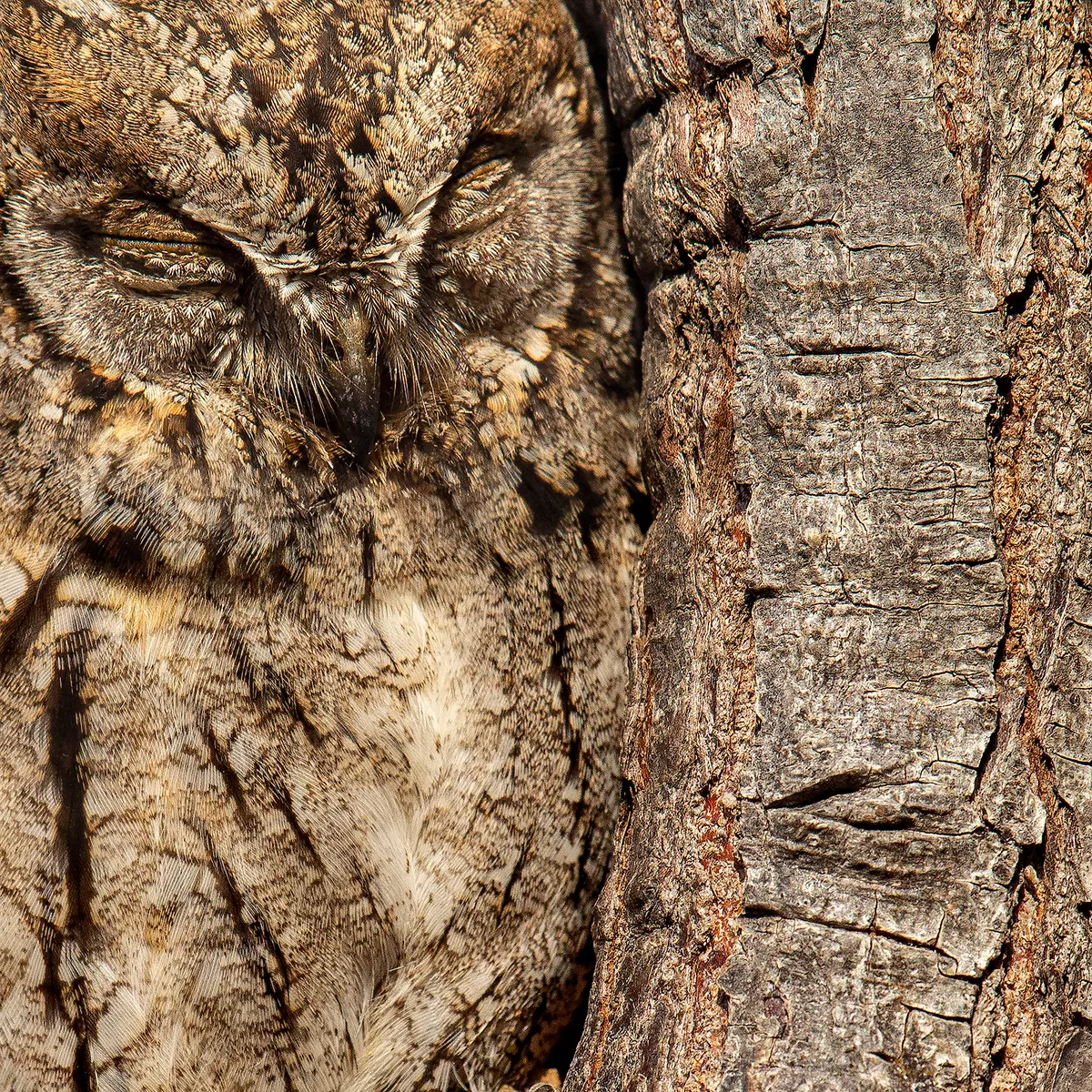
PERFECT CAMOUFLAGE, Eurasian scops-owl (Otus scops). Moshe Cohen, Israel. Kibbutz Hatzor, Israel.
This owl lives very close to my home – I know this because I hear its sonar-ping call in the night. However, finding and seeing the bird is a different matter as the species is notoriously difficult to spot, being adept at blending in with its surroundings. The plumage is a superb match for tree bark and it puts this camouflage to good use by roosting in appropriate settings. On this occasion I found the bird during the daytime, but it is still hard to see where owl ends and bark begins.
Category: Attention to Detail, Silver award winner
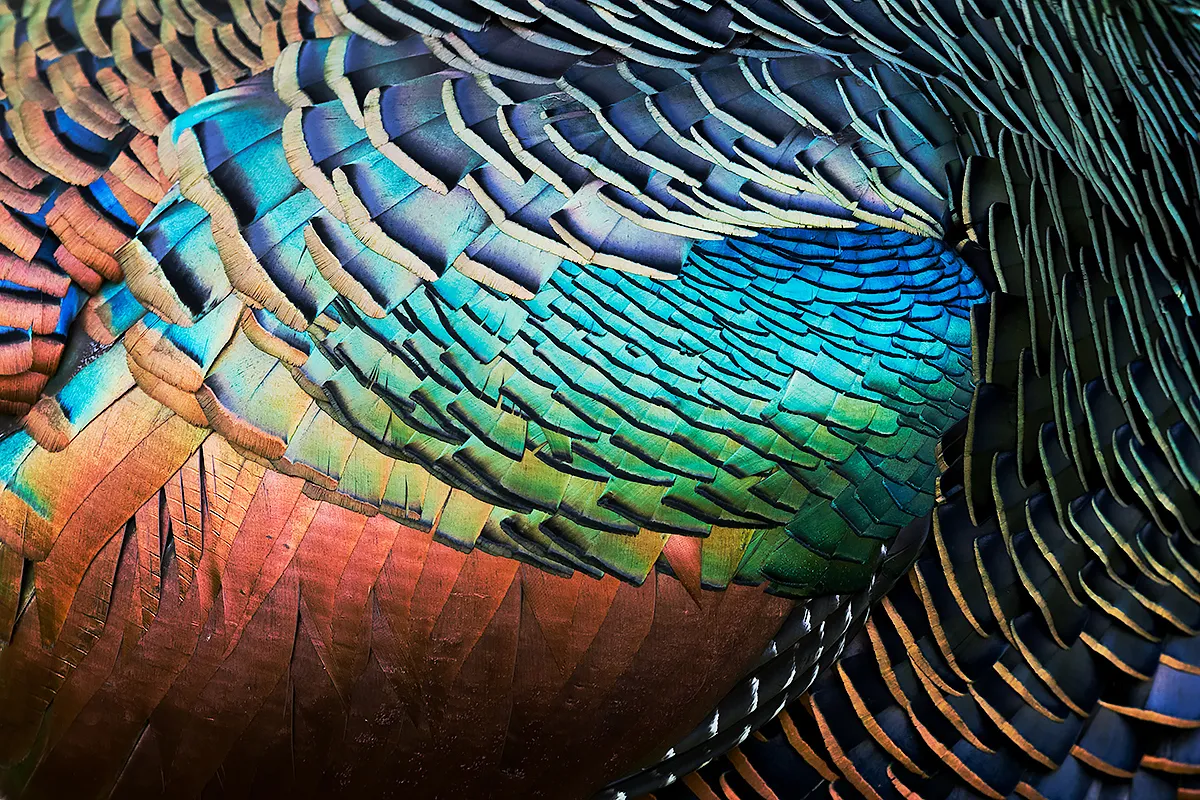
RAINBOW OF THE FOREST, Ocellated turkey (Meleagris ocellata). Tikal, El Péten, Guatemala. Mathias Putze, Germany.
It was never my plan to take a picture like this. Just seeing this extraordinary bird was as much as I expected. Luckily, however, the combination of thousands of visitors to the Mayan remains and the prohibition of any hunting inside Tikal National Park mean wildlife is quite relaxed. I was more than surprised to find an adult male ocellated turkey preening at the forest edge not far from the trail. What a treat. Elsewhere in Central America the species is often persecuted, and either rare, or wary of people, or both.
Category: Attention to Detail, Bronze award winner
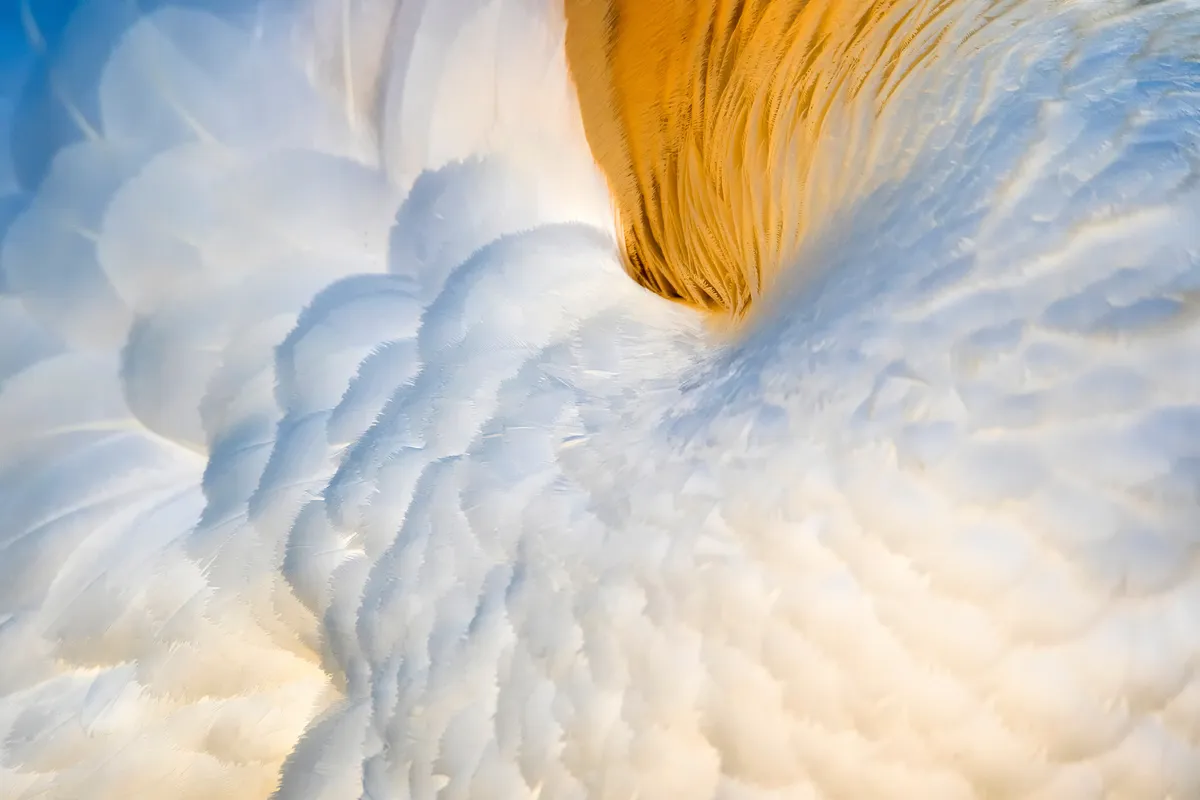
GANNET FLOWER, Northern gannet (Morus bassanus). Saltee Islands, Ireland. Francis De Andrés, Spain.
This photograph shows the detail of, and contrast between, the colours and textures of the plumage of a Northern Gannet, concentrating on the area between the body and the neck. To some the photo resembles a flower; to others it is like the sun emerging amid a bank of cumulus clouds.
The photograph was taken on the Saltee Islands, a place where a large colony of gannets reside. After fishing in the water, the birds usually perch on the cliff rocks to dry their plumage, affording superb opportunities for photographers.
Category: Creative Imagery, Gold award winner
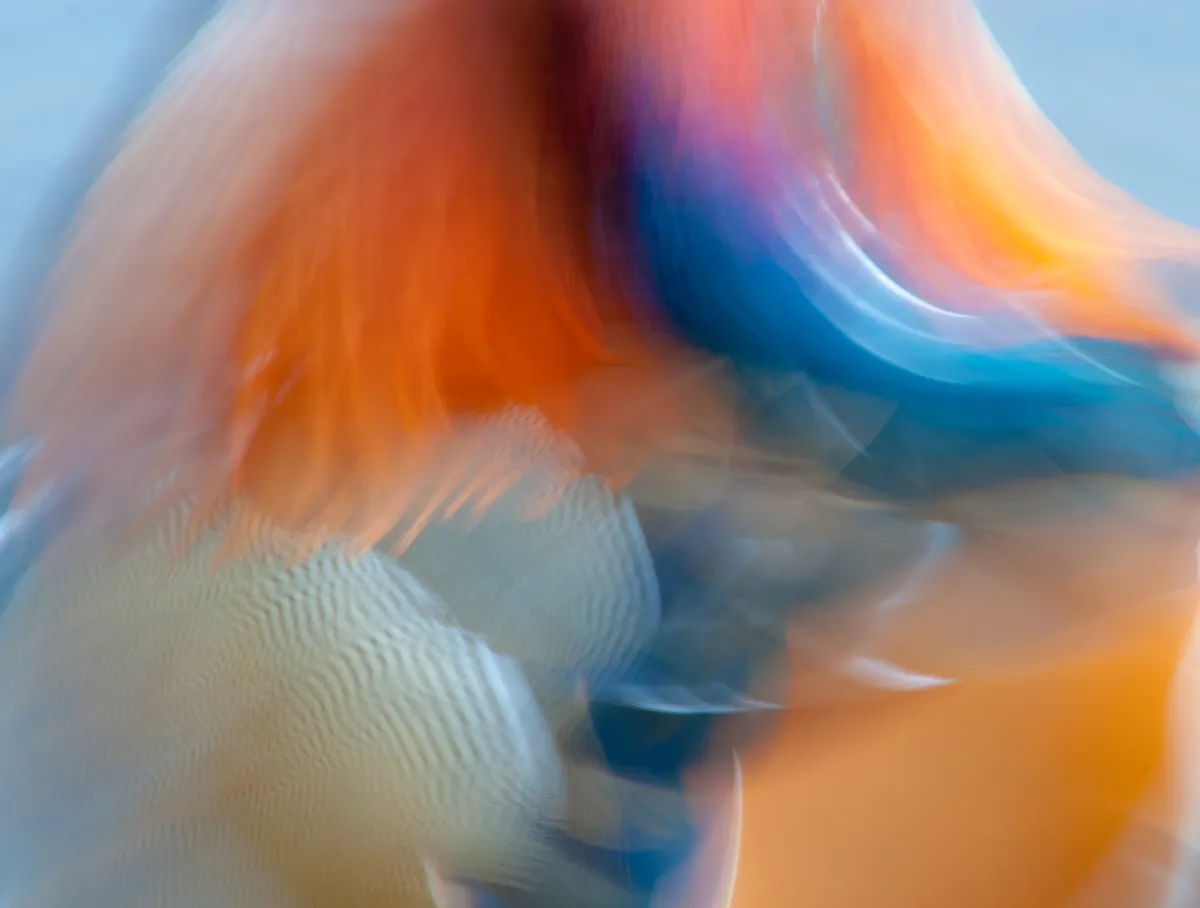
MANDARIN ABSTRACT. Mandarin duck (Aix galericulata). South Yorkshire, United Kingdom. James Hudson, United Kingdom.
The Mandarin drake has arguably the most flamboyant plumage of any bird living in the UK. In Sheffield there are several places where Mandarins can be found living alongside people. In some cases, these wild ducks see humans more as a supplier of free food than a threat.
As a result, I was able to get close enough to this individual to experiment with long-exposure photography and intentional camera-movement techniques. I wanted to create abstract images that captured the vibrancy of the ducks feathers as well as the excitement I feel when I see these extraordinary birds.
Category: Creative Imagery, Silver award winner
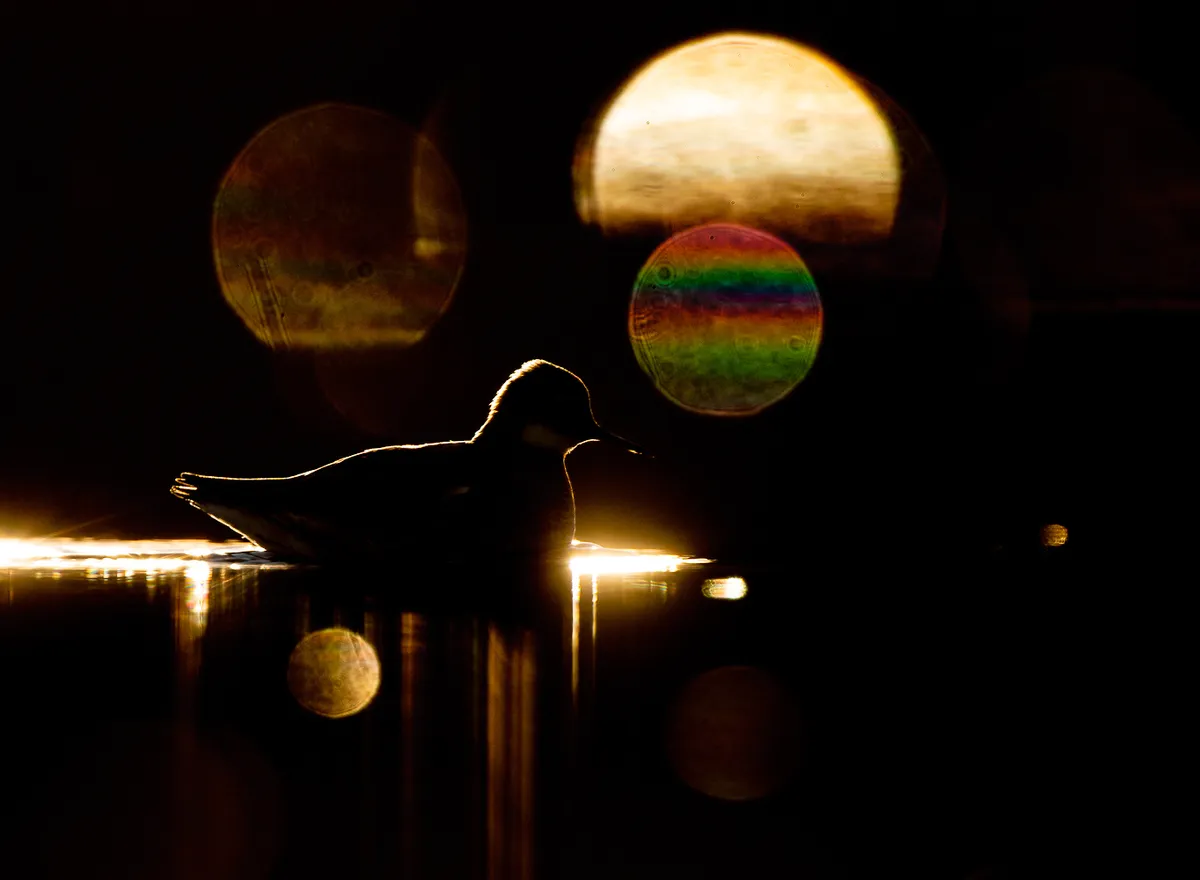
PHALAROPE REFLECTIONS. Red-necked phalarope (Phalaropus lobatus). Utqiagvik, Alaska, United States of America. Terje Kolaas, Norway.
A few red-necked phalaropes were gathered on a small pond and a hill created a dark background, making the location perfect for backlight photography. The low midnight sun of Alaska made it possible to photograph through the ‘night’, and this is one of thousands of shots from the particular session. The low-angle backlight, taken through a big telephoto lens, creates the reflections.
Category: Creative Imagery, Bronze award winner
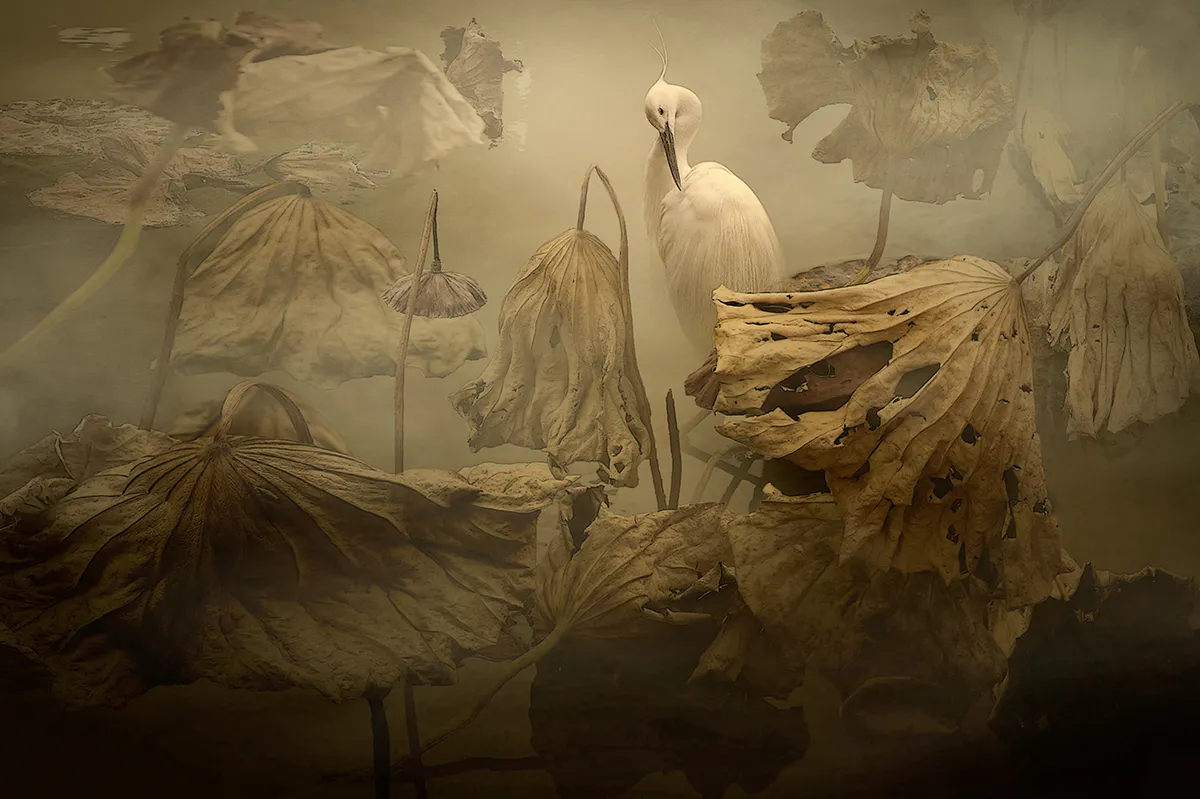
MAKE-UP. Little egret (Egretta garzetta). Deqing, Zhejiang, China. Chengbo Sun, China.
The images used in the creation of this collage were taken on 21 April 2017 while hand-holding the camera at Xiazhu Lake National Wetland Park in the town of Wukang; this is located in Deqing county, in China’s Zhejiang province.
The egret was preening, and I combined this image with shots of lotus leaves in various stages of growth and decay to create an impressionistic scene, whose qualities are halfway between two and three dimensions in character.
Category: Garden and Urban Birds, Gold award winner
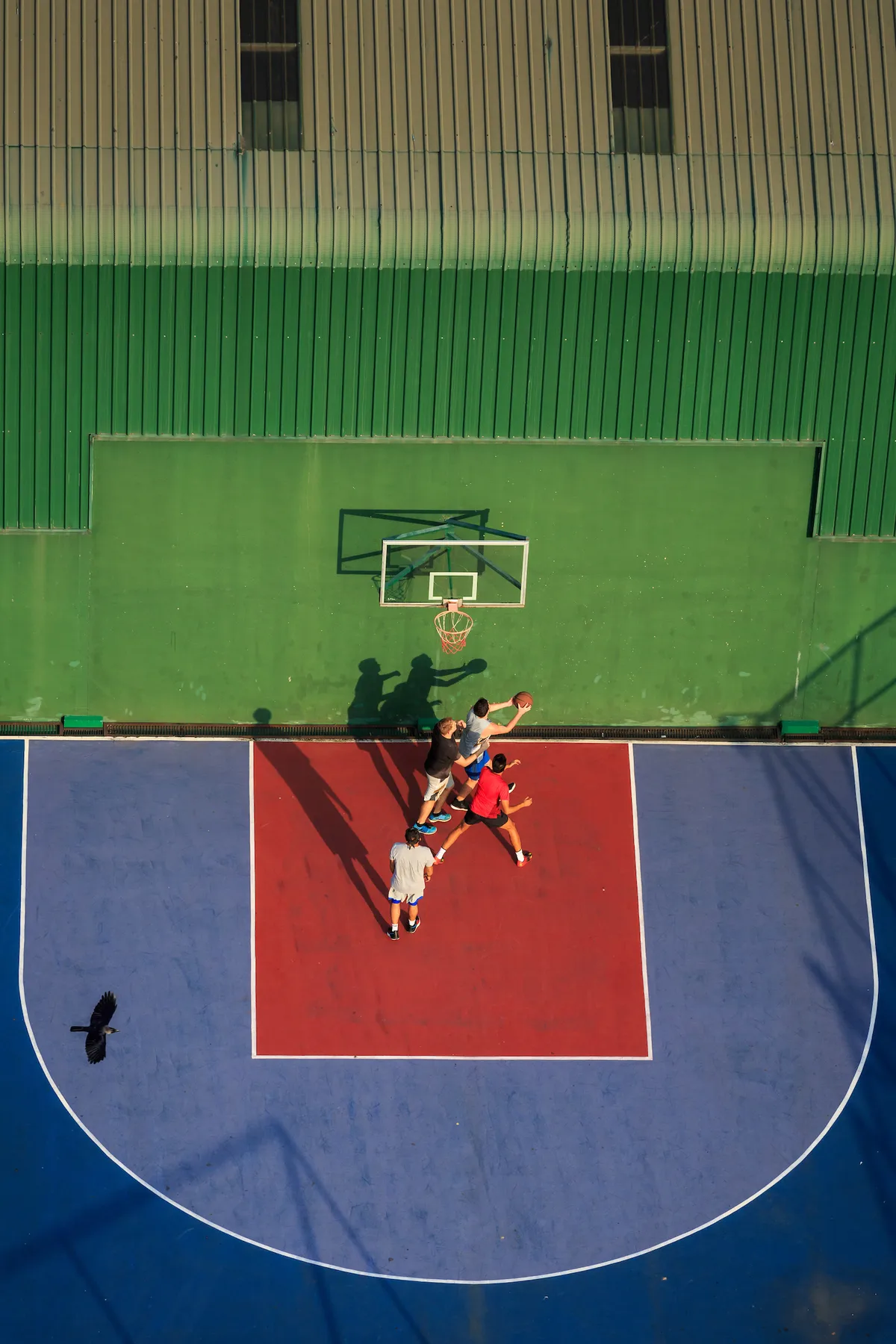
PHOTOBOMBING A GAME. House crow (Corvus splendens). Colombo, Sri Lanka. Magdaléna Straková, Czech Republic.
I was staying in an apartment in a high-rise building in Colombo and noticed this street basketball court under my balcony. I waited for a group of locals to come there in the evening and after I finally saw someone playing, I got out on the balcony. I leaned towards the railings to start shooting with my long lens pointing downwards and immediately regretted the idea – the metal railing was still blisteringly hot from the sun!
Carefully balancing over the railings (20 floors up!) so as not to burn myself again, I took several series of shots. But I felt something was still missing… When I noticed the crow flying by, I quickly shot a couple more frames. I immediately knew that this was the element I had been waiting for to ‘complete’ my picture!
Category: Garden and Urban Birds, Silver award winner
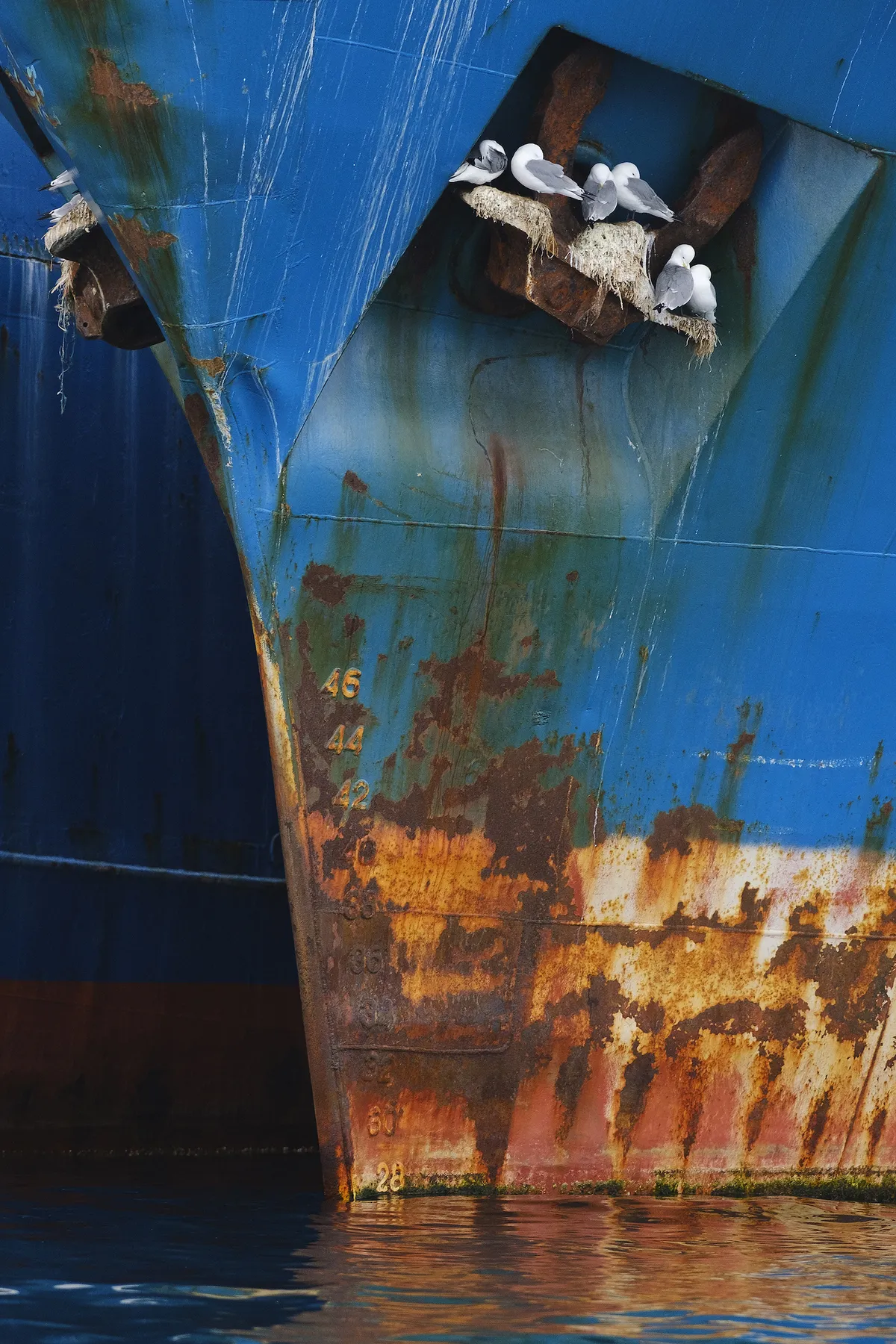
THE OLD SHIP. Black-legged kittiwake (Rissa tridactyla). Båtsfjord, Norway. Kiko Arcas, Spain.
In the coastal town of Båtsfjord in northern Norway there is a small colony of black-legged kittiwakes that breed in the most unlikely of places – an old ship. Our guide, Øyvlind, took us in a Zodiac to a ‘graveyard’ of large fishing boats where a large colony of kittiwakes had made that place their home. There were numerous nests, on occupied windows, old anchors, tyres and all manner of human artefacts. It was an incredible place and one that I hope to return to.
Category: Garden and Urban Birds, Bronze award winner
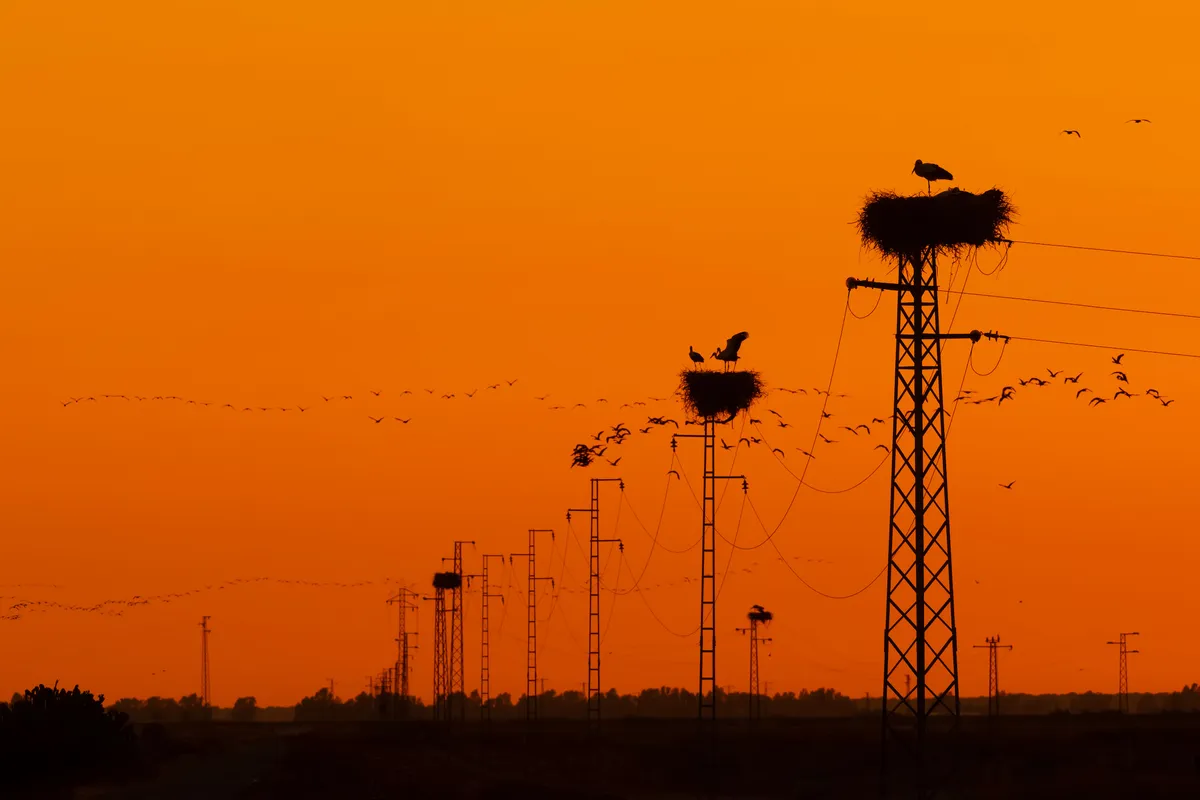
ELECTRIC. White stork (Ciconia ciconia). Seville, Spain. Carlos Cifuentes.
It is estimated that more than 200,000 birds die each year on the Iberian Peninsula due to collisions with high-voltage power lines. Despite this, white storks still build their nests on top of the electric towers, demonstrating their taste for using man-made constructions from which they can command a sweeping view. The photograph was taken hand-held late in the day, when the nests were occupied and hundreds of glossy ibises were returning to roost.
Category: Inspirational Encounters award
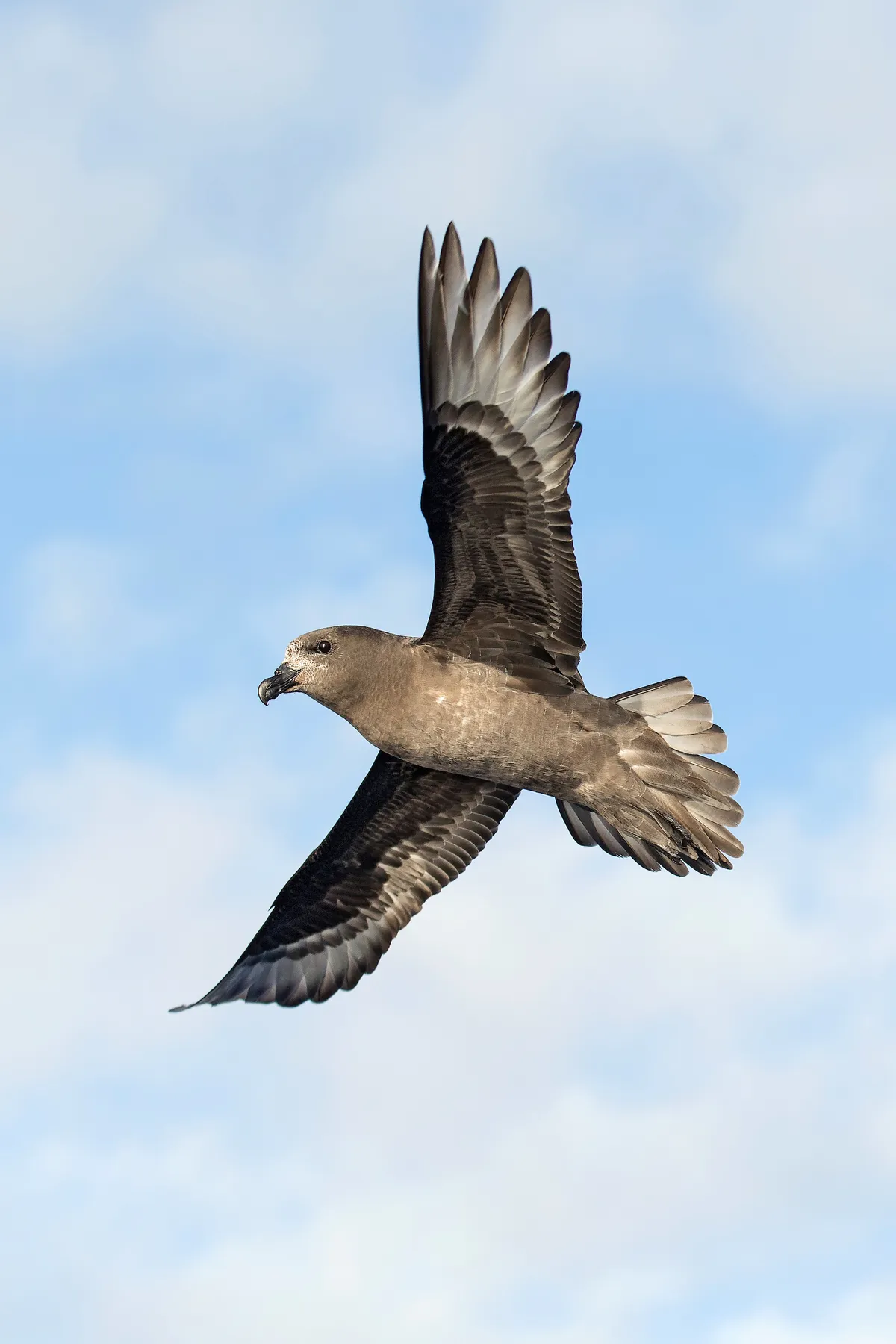
HOMECOMING. Providence petrel (Pterodroma solandri). Lord Howe Island, Australia. Gail Bisson, Canada.
Years before I became interested in bird photography, I read The Fatal Shore, a book about the colonisation of Australia and its brutal history of convict transportation. In the book, author Robert Hughes discusses the colonisation of Norfolk Island and details the sad fate of its Providence Petrels. The heartbreaking story remained in my mind and heart for years, and I long harboured a wish to someday see a Providence petrel. A recent trip to Australia allowed me to include a side trip to Lord Howe Island and have my dream realised.
The petrels were called Providence Petrels because they provided the only food available to the transported convicts from England when they landed on Norfolk Island in the late 1700s. The petrels were exterminated on Norfolk Island between 1790 and 1800. One million adults and young were harvested for food from 1790 to 1793, and numbers had dropped to 15,000 by 1796, with complete extermination by 1800.
Today, other than a few pairs found nesting on Norfolk Island, and more recently a few pairs on Phillip Island, 99.9 per cent of the world population of Providence petrels nest on Mt Gower on Lord Howe Island (roughly 32,000 pairs). The species is classed as Vulnerable. Its name is both ironic and heartbreaking, because the presence of humans was hardly ‘providential’ for these petrels.
This past winter, Lord Howe Island started a rat-extermination programme. By eliminating the rats it is hoped that petrel numbers will rise to a new high. What a wonderful moment it was to watch the petrels returning at dusk to Mt Gower.
Category: Best Portfolio
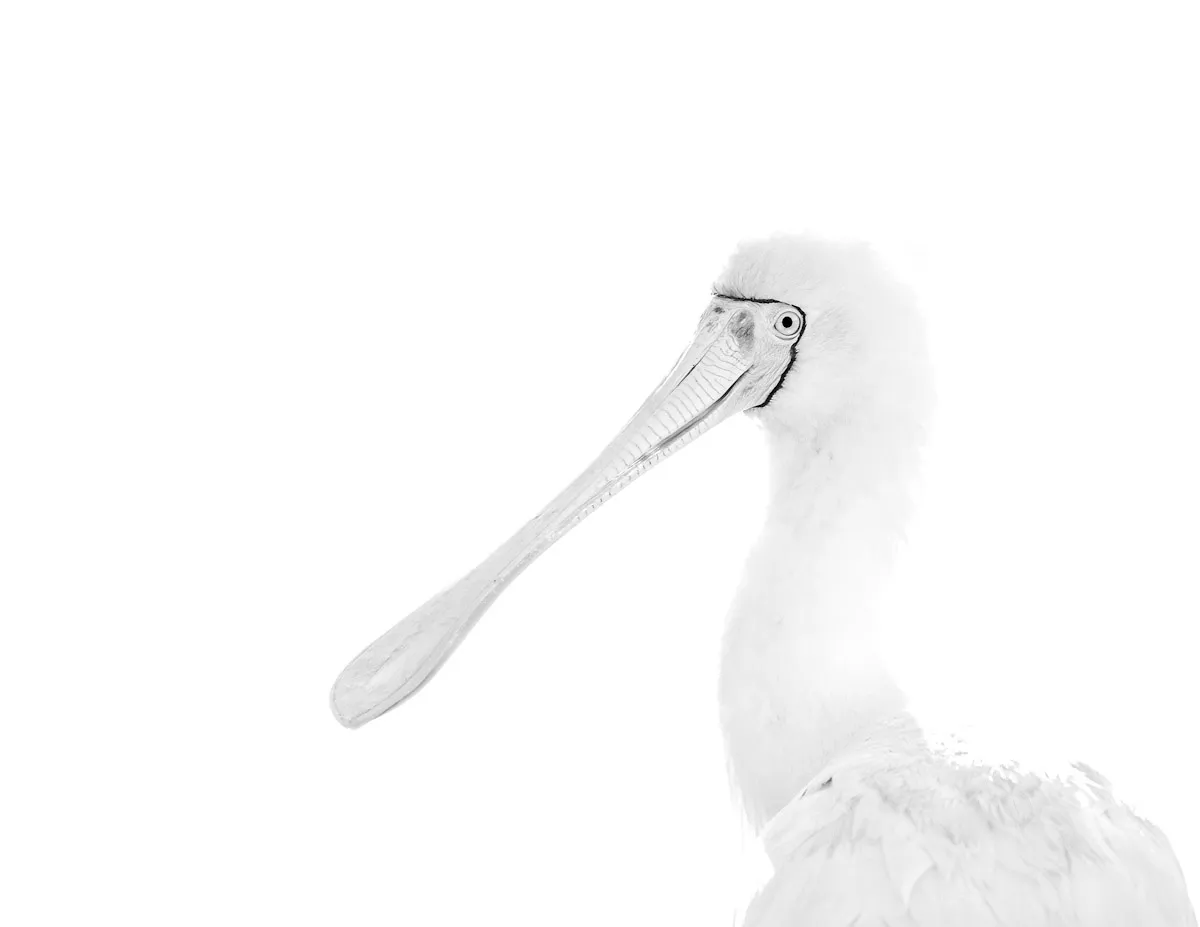
WHITE ON WHITE. Yellow-billed spoonbill (Platalea flavipes). Avon River, Northam, Western Australia, Australia. Georgina Steytler, Australia.
I like to experiment with exposures and minimalist compositions. In this case, I photographed the bird looking into the direction of the sun. Ordinarily, the bird would have been silhouetted, but I chose to overexpose by several stops, completely losing detail in the background but perfectly exposing the bird. The feathered edges of the bird were blown out, giving an appealing halo.
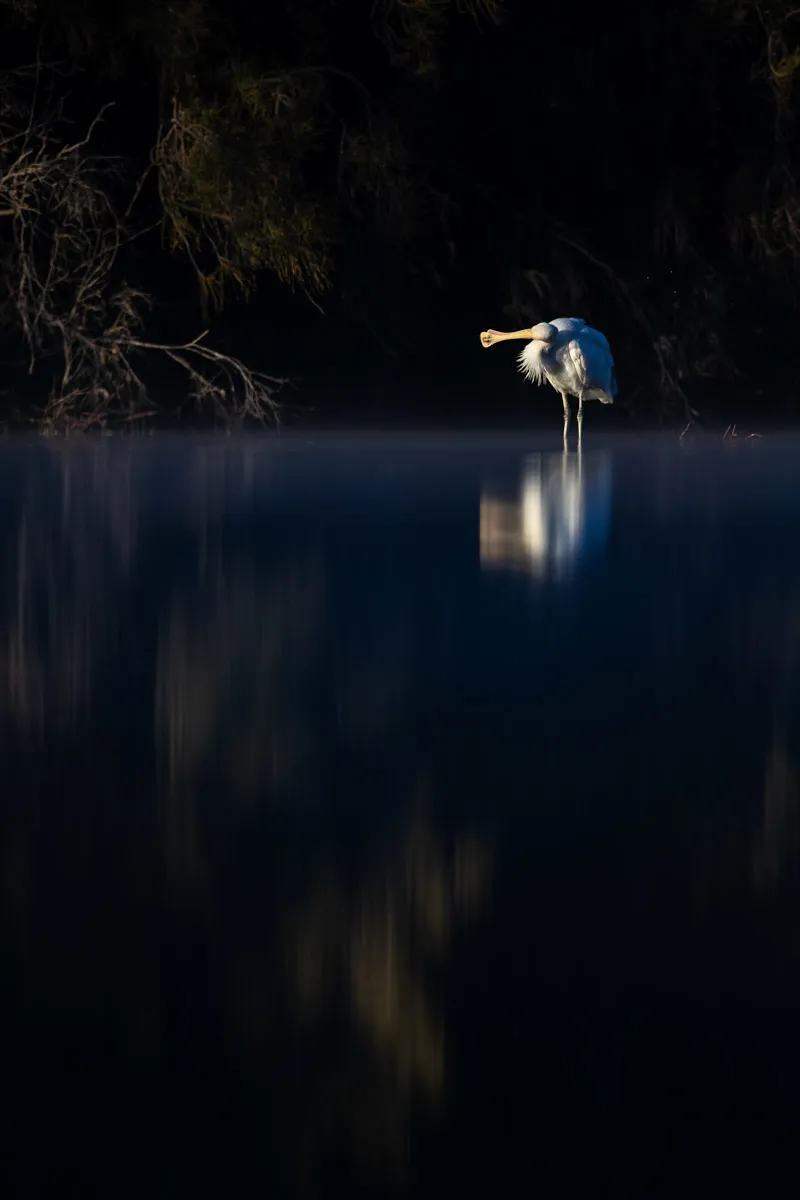
THE SHAKE. Yellow-billed spoonbill (Platalea flavipes). Avon River, Northam, Western Australia, Australia. Georgina Steytler, Australia.
This part of the Avon River in my local area is not particularly attractive, but on this morning there was a beautiful mist across the water. I chose a position where the yellow-billed spoonbills were feeding against a dark background and set my exposure for the birds. This bird was catching the light of the rising sun and contrasted beautifully against the shadows.
I lay low to the water and chose a composition that was out of the ordinary to engage the imagination, and I picked up the flecks of reflections in the water to add depth to the image. I also love a bird that adopts an interesting pose.
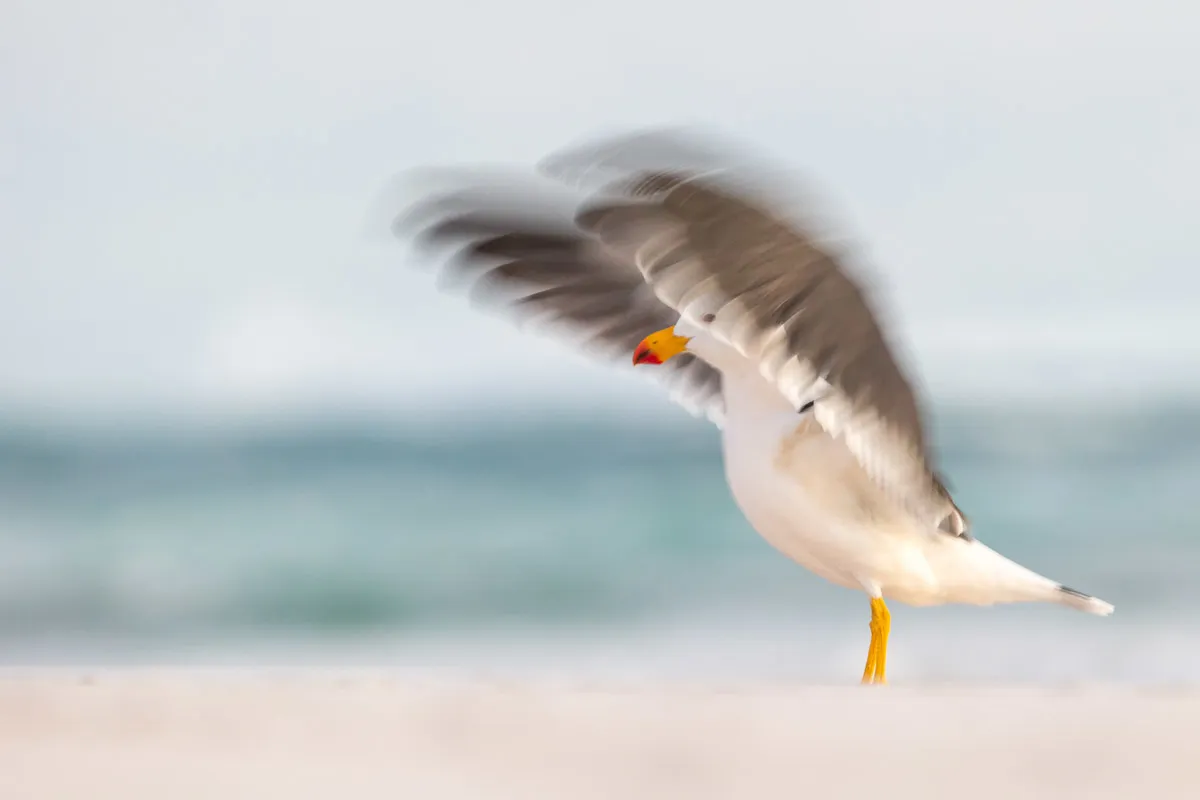
PACIFIC GULL BLUR. Pacific gull (Larus pacificus). Jurien Bay, Western Australia, Australia. Georgina Steytler, Australia.
The sun had set in a coastal town of Western Australia when I saw this Pacific Gull bathing in the waves. I used a slow shutter speed as it was quite dark, and experimented. This is a shot of the bird after it emerged from the water and flapped its wings to remove the excess.
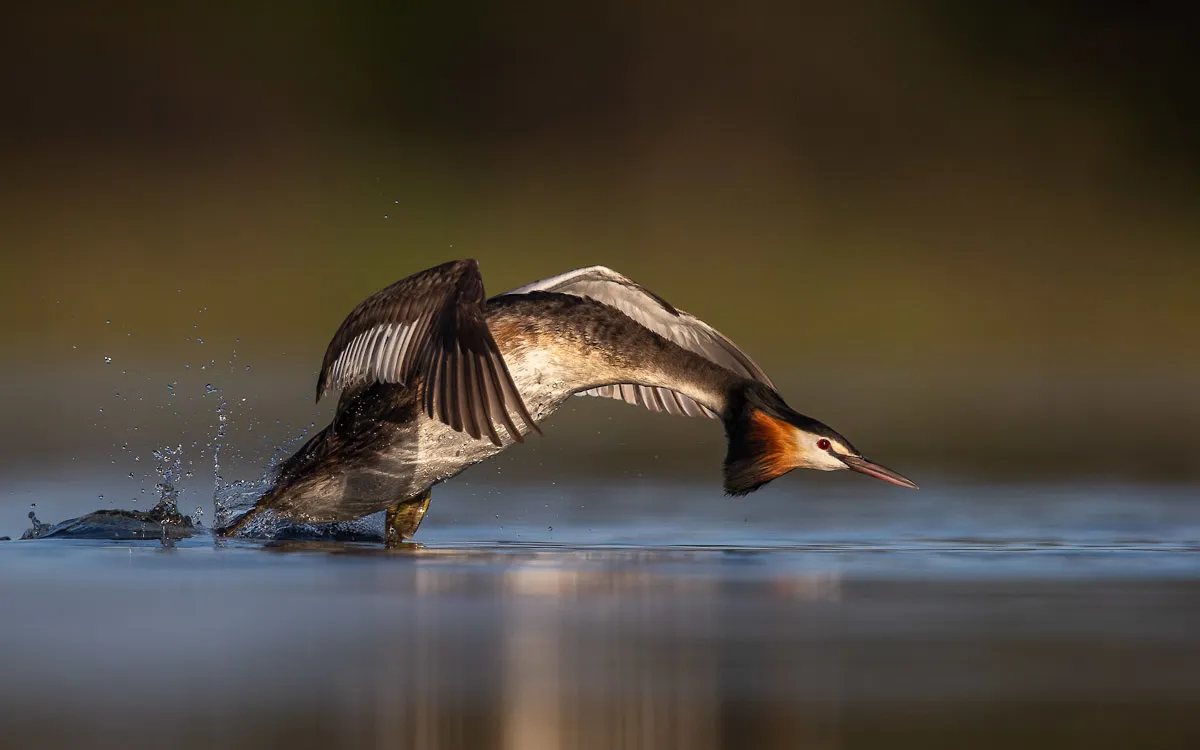
ON THE ATTACK! Great crested grebe (Podiceps cristatus). Perth, Western Australia, Australia. Georgina Steytler, Australia.
Several pairs of great crested grebes nest on a lake in Perth. I spent a week observing their behaviour around breeding time, lying by the lake shore. This bird spied another grebe coming too close and was taking off to shoo the intruder away from his territory.
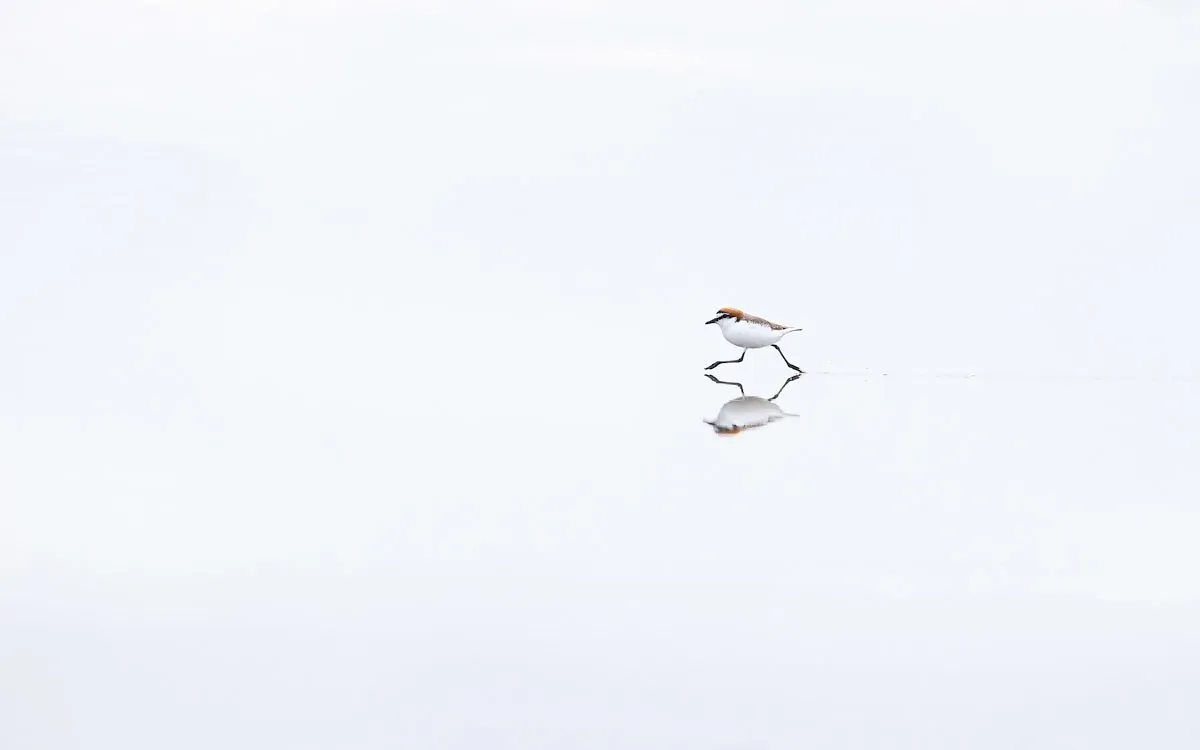
ON THE RUN. Red-capped plover (Charadrius ruficapillus). Hopetoun, Western Australia, Australia. Georgina Steytler, Australia.
I was fortunate to come across an inlet on a still day with almost mirror-perfect water and some cute little red-capped plovers. I used a fast shutter speed to track this bird as it scurried across the water. These plovers are incredibly quick when they move, so I was delighted to get this image. I like the white on white, and I like the contrast of the small bird in a big watery world.
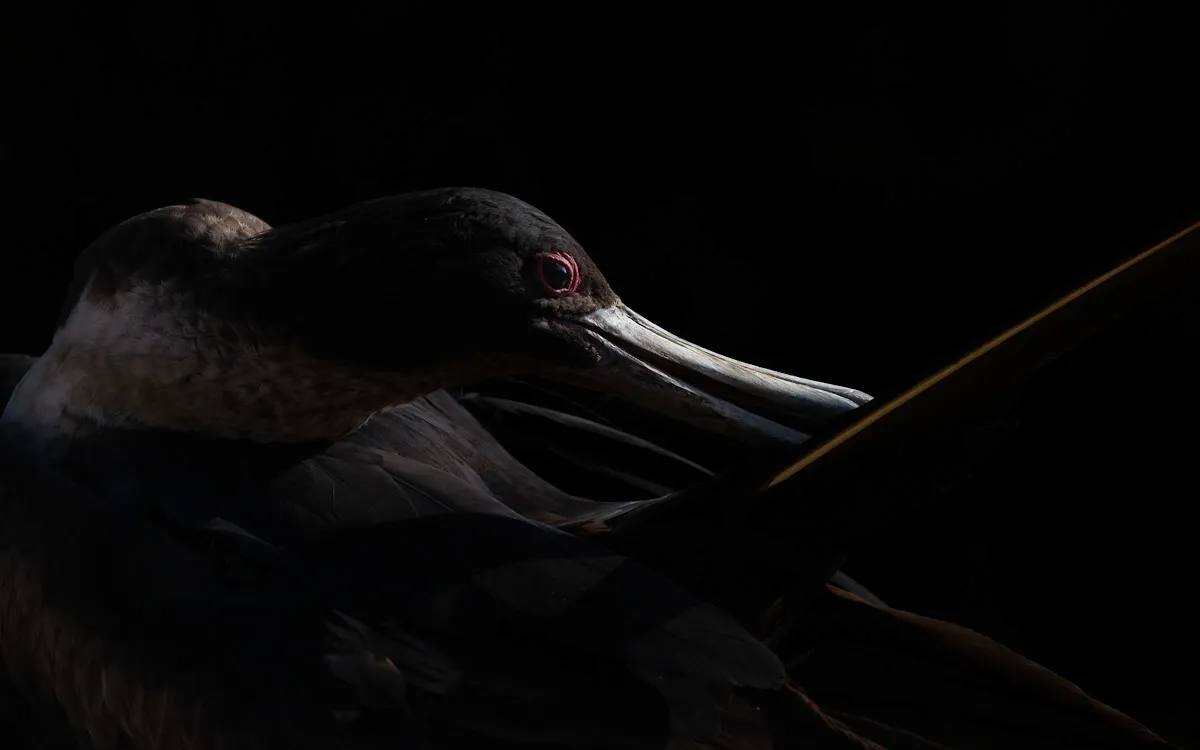
THE PREEN. Great frigatebird (Fregata minor). Christmas Island, Australia. Georgina Steytler, Australia.
This great frigatebird was preening in quite hash sunlight. I positioned myself so that the shadow of a large tree was behind the bird. I then underexposed the background by several stops of light to take advantage of the dramatic lighting. I love the yellow shaft of the tail feather that is usually visible only when the birds are in flight.
Category: Young Bird Photographer of the Year, 14-17 years
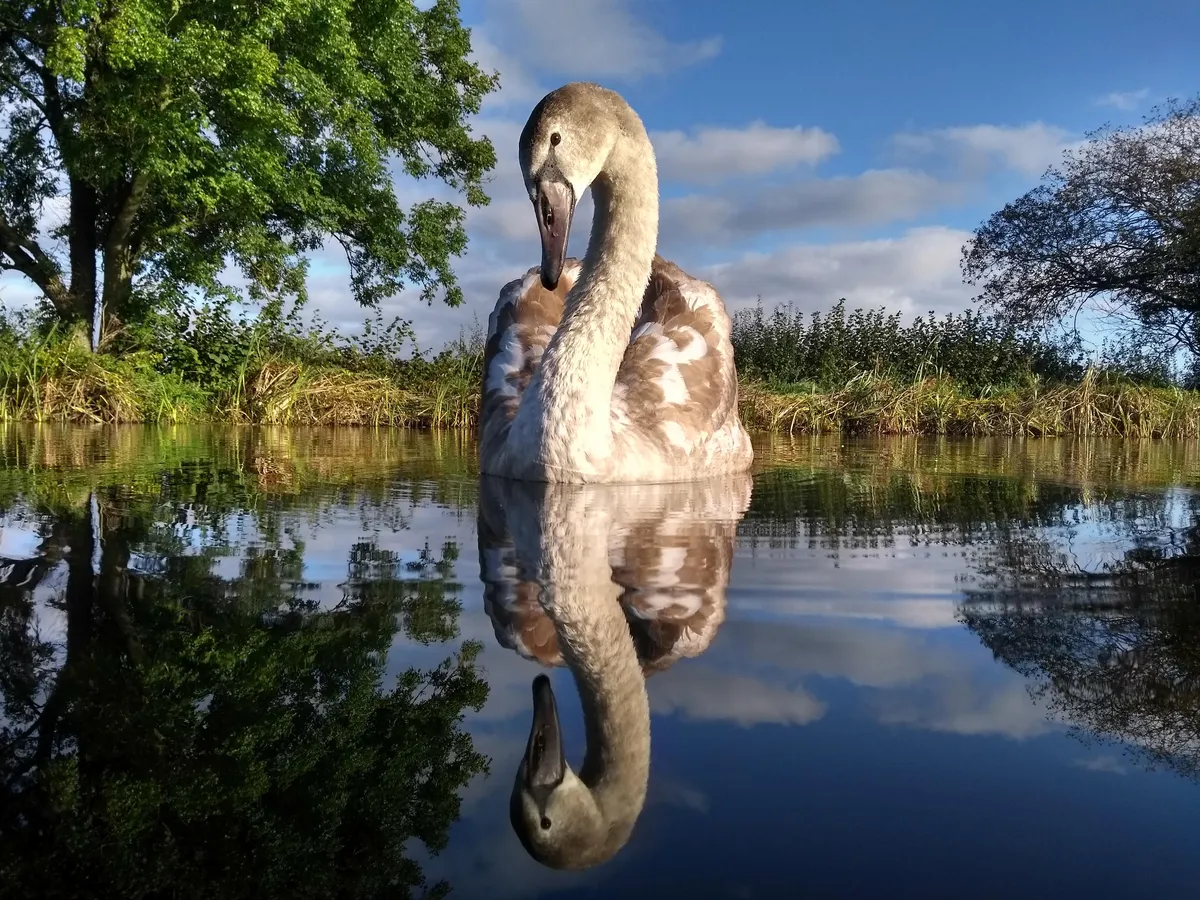
SEEING DOUBLE. Mute swan (Cygnus olor). Devon, United Kingdom. Adam Lake, United Kingdom. Age 17.
Category: Young Bird Photographer of the Year, 9-13 years
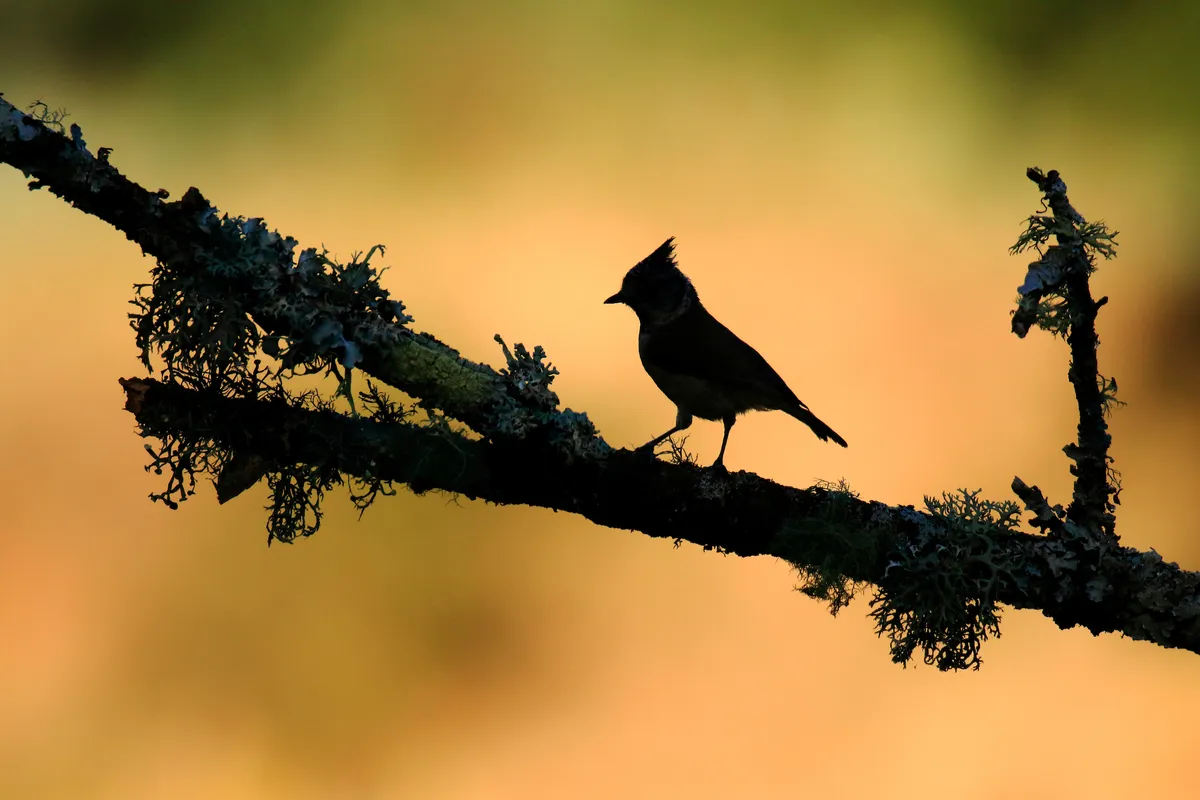
BACK-LIGHTING. Crested tit (Lophophanes cristatus). Grazalema, Andalusia, Spain. Ismael Domínguez Gutiérrez, Spain. Age 11.
This crested tit is perched on a twig, preparing to take a bath. The image was taken in the late afternoon as the suns rays added a warmth to the colours. By back-lighting the subject I was able to enhance the effect.
Category: Young Bird Photographer of the Year, 0-8 years
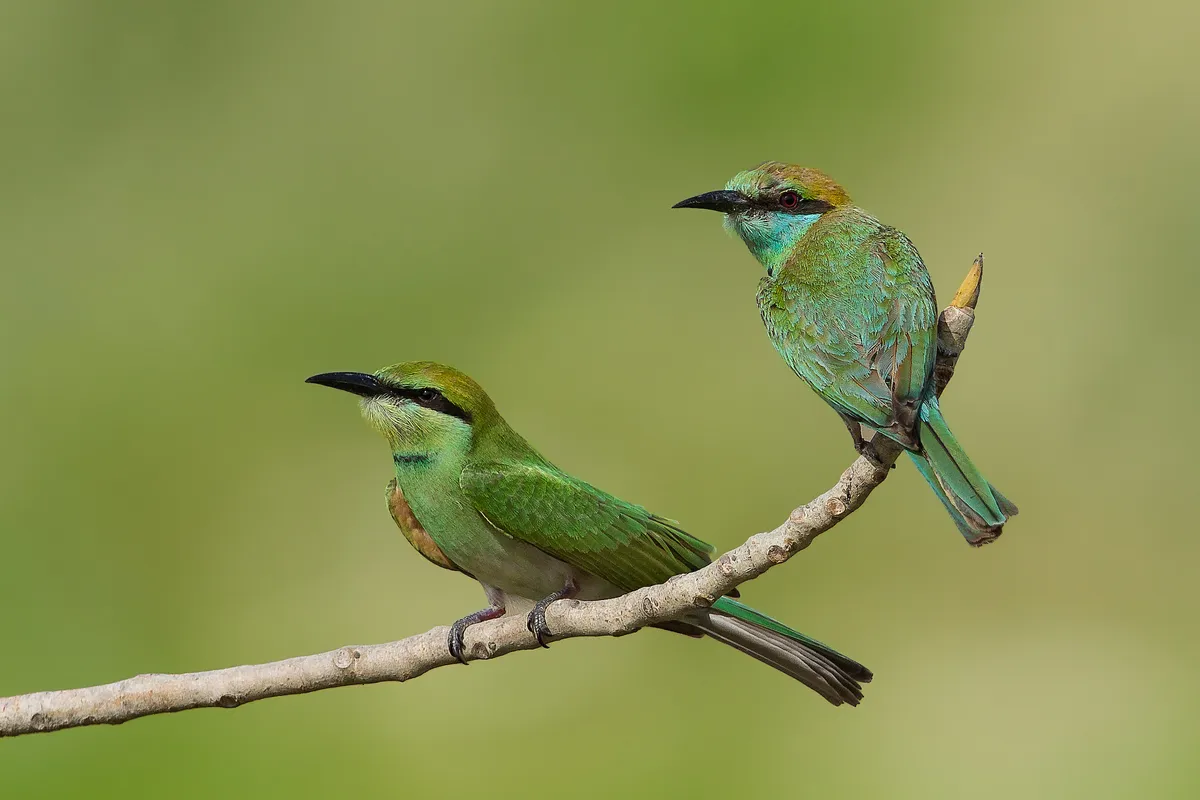
ASIAN GREEN BEE-EATER PAIR. Asian green bee-eater (Merops orientalis). Chennai, India. Deeksha Diya Sambath, India. Age 7.
My dad is a bird photographer and has been my inspiration; I love to accompany him on his weekend photography outings. This pair of Asian green bee-eaters are regular visitors to our backyard. I just love the colour of these birds and how they catch the bees in mid-air. I took this photograph from the car with my dad’s camera.
